State of California The Resources Agency
DEPARTMENT OF PARKS AND RECREATION
PRIMARY RECORD
Page 1 of 26
P1. Other Identifier:
Primary #
HRI #
Trinomial
NRHP Status Code 3CD, 5D2
Other Listings Review Code Reviewer Date
*Resource Name or #: (Assigned by recorder) Lavender Heights Historic District
*P2. Location: Not for Publication Unrestricted
*a. County Sacramento and (P2c, P2e, and P2b or P2d. Attach a Location Map as necessary.)
*b. USGS 7.5' Quad Sacramento East, CA Date 2021 T 8N ; R 5E ; of Mt. Diablo of Sec 00 ; B.M.
c. Address 20th and K Streets City Sacramento Zip 95811
d. UTM: (Give more than one for large and/or linear resources) Zone , mE/ mN
e. Other Locational Data: (e.g., parcel #, directions to resource, elevation, decimal degrees, etc., as appropriate)
See boundary description, District Record, Page 2.
*P3a. Description: (Describe resource and its major elements. Include design, materials, condition, alterations, size, setting, and boundaries) Lavender Heights is an enclave of cultural landmarks associated with the history of Sacramento’s LGBTQ+ community. The district consists of commercial and institutional properties historically centered around the intersection of 20th and K Streets in Sacramento’s Midtown neighborhood. District contributors include 12 commercial, institutional, and converted residential buildings that are associated with the development of a visible LGBTQ+ community in Sacramento, starting in 1967 through the year 2000, when increasing integration of the LGBTQ+ community into mainstream society resulted in distinct changes to the tight-knit character of the community. The district also contains 29 non-contributing properties. (Continued on page 2).
*P3b. Resource Attributes: (List attributes and codes) HP6. 1-3 story commercial building, HP16. Religious building, HP13. Community center/social hall
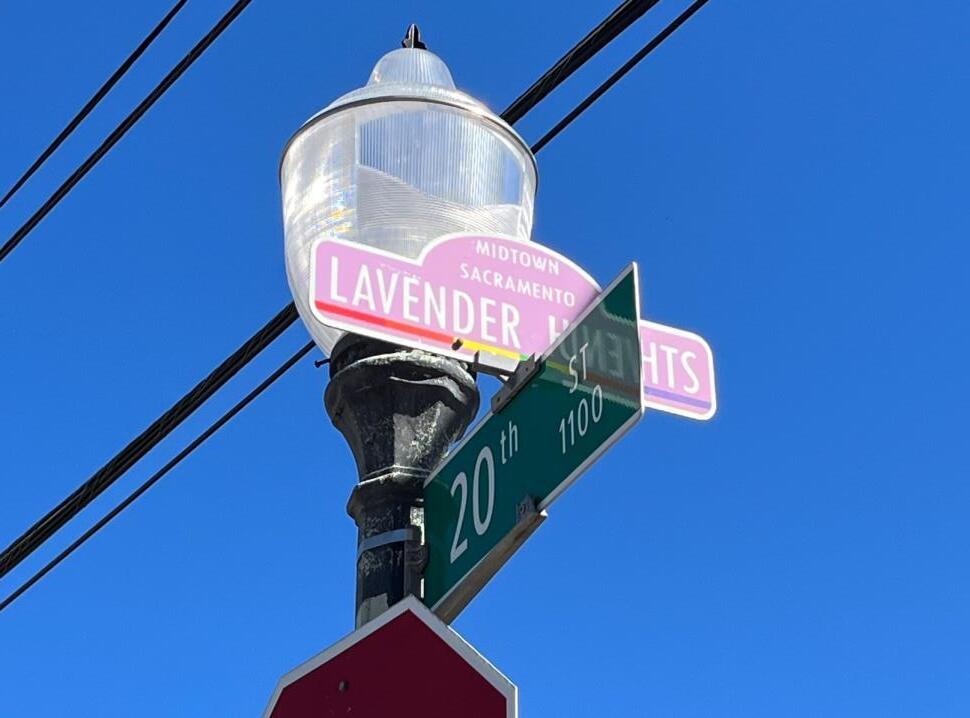
*P4. Resources Present: Building Structure Object Site District Element of District Other (Isolates, etc.)
P5b. Description of Photo: (view, date, accession #) Lavender Heights sign marker at 20th and K streets, view east.
*P6. Date Constructed/Age and
Source: Historic Prehistoric Both ca.1895-1972 (Sacramento County Assessor Year Built data)
*P7. Owner and Address: Multiple private owners
*P8. Recorded by: (Name, affiliation, and address) Page & Turnbull, Inc., 1007 7th Street, #404, Sacramento, CA 95814
*P9. Date Recorded: September 25, 2024
*P10. Survey Type: (Describe) Intensive
*P11. Report Citation: (Cite survey report and other sources, or enter "none.") Page & Turnbull, “Sacramento LGBTQ+ Historic Experience Project Historic Context Statement,” 2024
*Attachments: NONE Location Map Continuation Sheet Building, Structure, and Object Record
Archaeological Record District Record Linear Feature Record Milling Station Record Rock Art Record
Artifact Record Photograph Record Other (List):
Page 2 of 26
*NRHP Status Code 3CD, 5D3
*Resource Name or # (Assigned by recorder) Lavender Heights Historic District
D1. Historic Name: Lavender Heights
*D3
D2. Common Name: Lavender Heights
Detailed Description: (Discuss overall coherence of the district, its setting, visual characteristics, and minor features. List all elements of district.)
The district is located in the urban core of Midtown Sacramento, which is zoned C-2-SPD (General Commercial/Special Planning District). Midtown is platted on a gridded streetscape with low- to medium-density land use including one- to three- story commercial buildings; areas of historic and infill single- and multi-family housing, some of which have been converted to commercial use; larger formerly industrial buildings; religious buildings; several larger office buildings and parking garages; and paved surface parking lots. East-to-west arterial streets are bisected by alleyways, which have street names. Examples of historic housing date to the late 19th and early 20th centuries and include single- and multi-family houses and apartment buildings designed in the vernacular, Queen Anne, Italianate, Stick-Eastlake, Craftsman, Prairie, Art Moderne, and Classical Revival styles. Commercial, institutional, and residential buildings throughout the district do not conform to a cohesive style or period of construction and include examples of adaptive reuse of late 19th-century residential properties for commercial use, along with contemporary storefronts and infill dating to the 1980s and 1990s. Contributors to the district include the locations of community centers; gay bars; businesses that were owned by and catered to members of the community; offices of organizations and individuals that provided essential health and welfare services to the community, including during the AIDS epidemic; and a church that hosted events and provided spiritual sustenance.
The contributing elements of Lavender Heights Historic District are listed in Table 1 below and described in detail beginning on page 3 of the attached Continuation Sheets
Table 1. Contributing Properties, Lavender Heights Historic District
919 20th Street 007-0016-017-0000 Lambda Community Center, Lambda Players, and AIDS Response Programs (ca. 1997-1999)
912 21st Street 007-0016-010-0000 Dr. Harvey Thompson and Dr. Sandy Pomerantz offices / The Open Book
5D3 No
5D3 No
1996-2005
2115 J Street 007-0022-015-0000
AIDS Foundation offices
2220 J Street 007-0093-007-0000 Sacramento Women's Center, Gifted Gardener
2224 J Street 007-0093-008-0000 Lioness Books, Sacramento Women's Center, Rape Crisis Center, WEST
5D3 No
1989 3DC, 5D3 No
5D3 No
State of California The Resources Agency
Primary #
DEPARTMENT OF PARKS AND RECREATION HRI #
CONTINUATION SHEET
Page 3 of 26
Trinomial
Resource Name or # (Assigned by recorder) Lavender Heights Historic District
*Recorded by Page & Turnbull, Inc. *Date September 25, 2024 Continuation Update
Contributing Elements APN
1900 K Street 007-0084-023-0000 Sacramento AIDS Foundation offices
3DC, 5D3 No
2000 K Street 007-0086-020-0000 K Street Station/Faces gay bar 1985-present 3DC, 5D3 Yes
2001 K Street 007-0085-012-0000 The Western/The Depot gay bar ca. 1997present 3DC, 5D3 Yes
1928 L Street 007-0143-007-0000 Mercantile Saloon gay bar
1931 L Street 007-0084-030-0000 Lambda Community Center, Lambda Players, Stop AIDS Project
Table 2. Non-Contributing Properties, Lavender Heights Historic District
NonContributing Elements APN Status Code
1209 19th Street 007-0143-002-0000 6Z
923 20th Street 007-0016-016-0000 6Z
1015 20th Street 007-0085-001-0000 6Z
1116 20th Street 007-0084-011-0000 6Z
1120 20th Street 007-0084-012-0000 6Z 924 21st Street 007-0016-011-0000 6Z
1011 22nd Street 007-0093-001-0000 6Z
2001 J Street 007-0016-015-0000 6Z
2011 J Street 007-0016-014-0000 6Z
2015 J Street 007-0016-019-0000 6Z
2020 J Street 007-0085-017-0000 6Z
2031 J Street 007-0016-018-0000 6Z
2101 J Street 007-0022-028-0000 6Z
2109 J Street 007-0022-016-0000 6Z
2124 J Street 007-0091-002-0000 6Z
2130 J Street 007-0091-011-0000 6Z
2200 J Street 007-0093-025-0000 6Z
1930 K Street 007-0084-031-0000 6Z
2007 K Street 007-0085-011-0000 6Z
2015 K Street 007-0085-015-0000 6Z
3DC, 5D3 Yes
1998 3DC, 5D3 No
State of California
CONTINUATION SHEET
Page 4 of 26
Trinomial
Resource Name or # (Assigned by recorder) Lavender Heights Historic District
*Recorded by Page & Turnbull, Inc.
NonContributing Elements
2025 K Street
K Street
K Street
K Street
1906 L Street
1914 L Street
L Street
L Street
L Street
*Date September 25, 2024 Continuation Update
007-0085-008-0000 6Z
007-0084-024-0000 6Z
007-0084-025-0000 6Z
007-0084-029-0000 6Z
007-0143-019-0000 6Z
007-0143-004-0000 6Z
007-0143-025-0000 6Z
007-0143-020-0000 6Z
007-0143-021-0000 6Z
*D4 Boundary Description: (Describe limits of district and attach map showing boundary and district elements.): The district is roughly bounded by I Street to the north between 20th and 21st Streets, 23rd Street to the east between Improv Alley and Jazz Alley, Liestal Alley to the south between 19th and 20th streets, and 19th Street to the west between Liestal Alley and K Street. (See Error! Reference source not found. on Continuation Sheet, page 5)
*D5. Boundary Justification:
By the 1970s, the foundations of a clearly identifiable, vibrant, openly gay neighborhood began to emerge in Sacramento. Known as Lavender Heights, the neighborhood was centered around the intersection of 20th and K streets and the surrounding blocks, though its boundaries were not clearly defined and evolved over time with the growth of LGBTQ+-owned and LGBTQ+-friendly business establishments in the Midtown area. The boundaries of the Lavender Heights Historic District encapsulate the epicenter of the larger landscape of Midtown Sacramento within which many of Sacramento’s LGBTQ+ residents lived, socialized, cared for one another, and coalesced into an identifiable, diverse, vibrant, and tight-knit community between the late 1960s to around the year 2000 As several landmarks within the broader Lavender Heights neighborhood are no longer extant, the historic district boundaries encompass the blocks where the highest concentration of extant LGBTQ+ properties are located; shown in the maps below (Error! Reference source not found.).
D6. Significance: Theme Social History Area City of Sacramento Period of Significance 1967-2000 Applicable Criteria 1/i and 2/ii (Discuss district's importance in terms of its historical context as defined by theme, period of significance, and geographic scope. Also address the integrity of the district as a whole.)
See Continuation Sheets, pages 8-24
*D7. References (Give full citations including the names and addresses of any informants, where possible.): See Continuation Sheet, page 25
*D8. Evaluator: Samantha Purnell and Clare Flynn Date: September 25, 2024 Affiliation and Address: Page & Turnbull, 1007 7th Street, #404, Sacramento, CA 95814
State of California The Resources Agency
Primary #
DEPARTMENT OF PARKS AND RECREATION HRI #
CONTINUATION SHEET
Page 5 of 26
Trinomial
Resource Name or # (Assigned by recorder) Lavender Heights Historic District
*Recorded by Page & Turnbull, Inc.
*D3 Detailed Description: (cont’d)
*Date September 25, 2024 Continuation Update
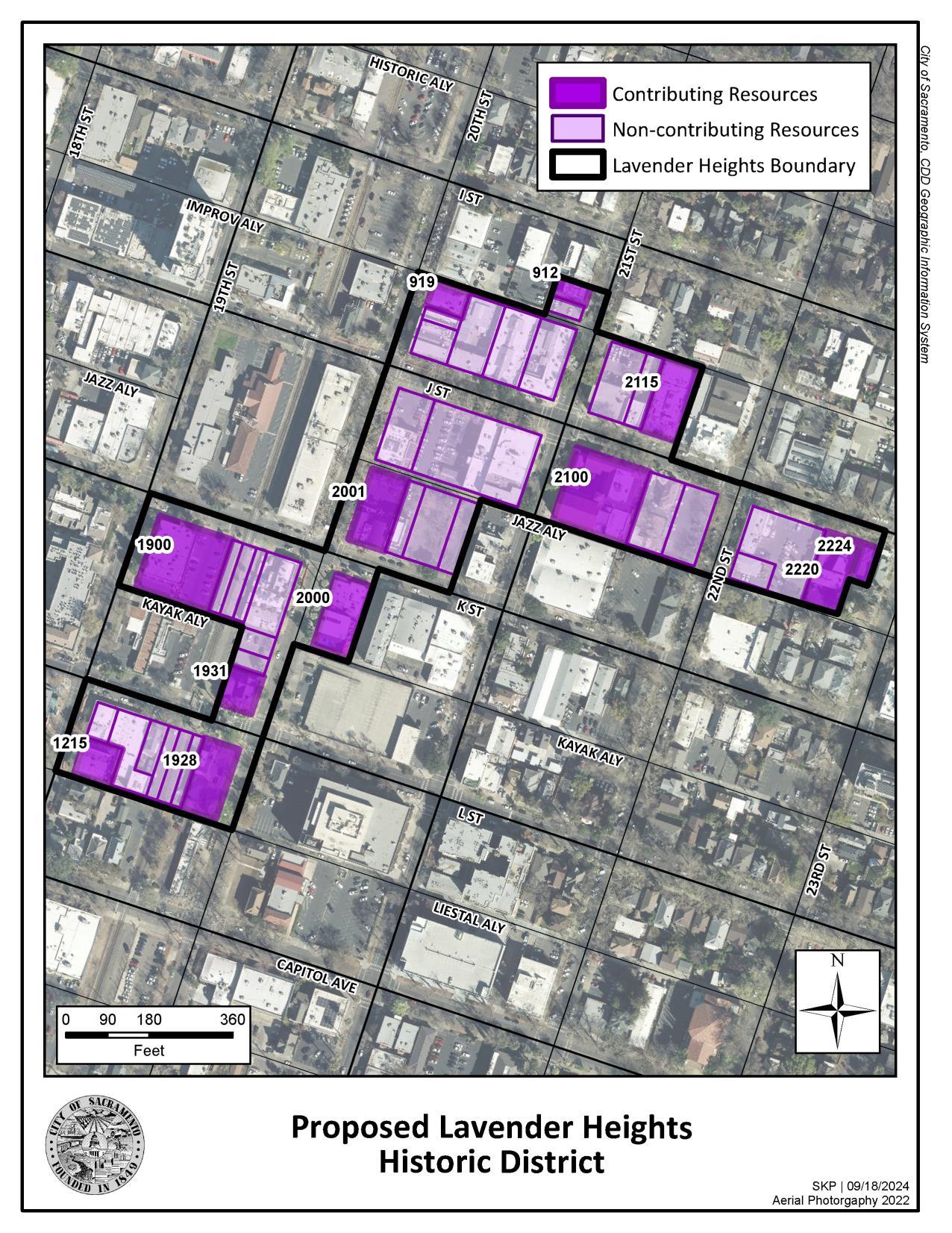
State of California The Resources Agency
Primary #
DEPARTMENT OF PARKS AND RECREATION HRI #
CONTINUATION SHEET
Page 6 of 26
Trinomial
Resource Name or # (Assigned by recorder) Lavender Heights Historic District
*Recorded by Page & Turnbull, Inc.
*D3 Detailed Description: (cont’d)
*Date September 25, 2024 Continuation Update
Table 2. Contributing buildings, Lavender Heights Historic District
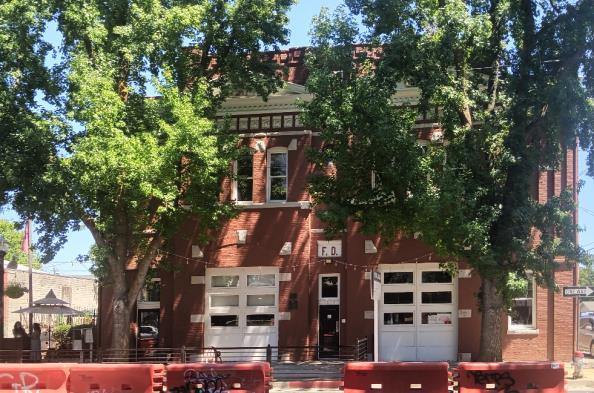
1215 19th Street (APN 007-0143-001-0000)
New Helvetia Roaster The property was occupied by New Helvetia Roaster from 1991-2002.
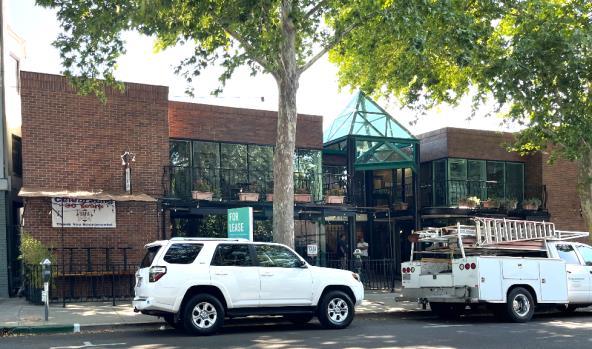
2115 J Street (APN 007-0022-015-0000) Sacramento AIDS Foundation. 2115 J Street was occupied by the
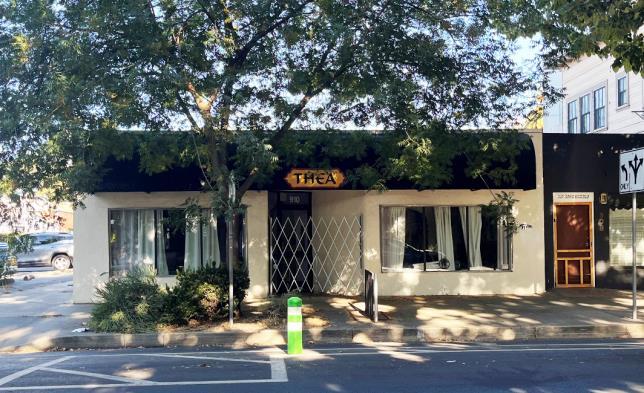
910-912 21st Street (APN 007-0016-010-0000)
Offices of Dr. Harvey Thompson and Dr. Sandy Pomerantz and the Open Book bookstore. The building housed the medical offices of Dr. Thompson and Dr. Pomerantz from 1978-1987 and the Open Book from 1996 to 2005
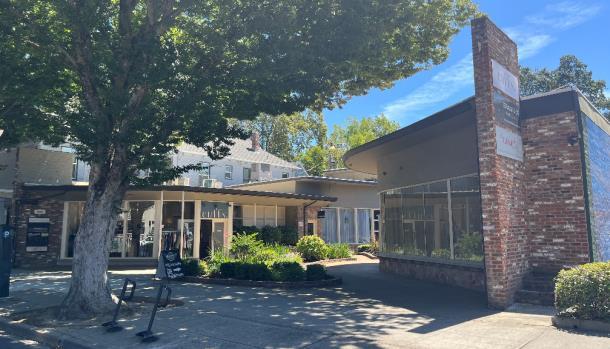
2220 J Street (APN 007-0093-007-0000)
Sacramento Women's Center and the Gifted Gardener 2220 J Street was occupied by the Sacramento Women's Center from 1975-1976 and was the first location of the Gifted Gardener in 1989.
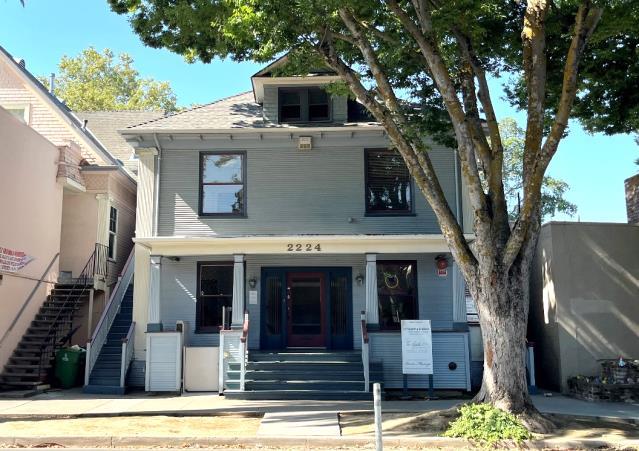
2224 J Street (APN 007-0093-008-0000)
Lioness Books. 2224 J Street was occupied by Lioness Books, Sacramento Women's Center Rape Crisis Center, and WEST from ca.1982-2000
DPR 523L (Rev. 1/1995)(Word 9/2013)
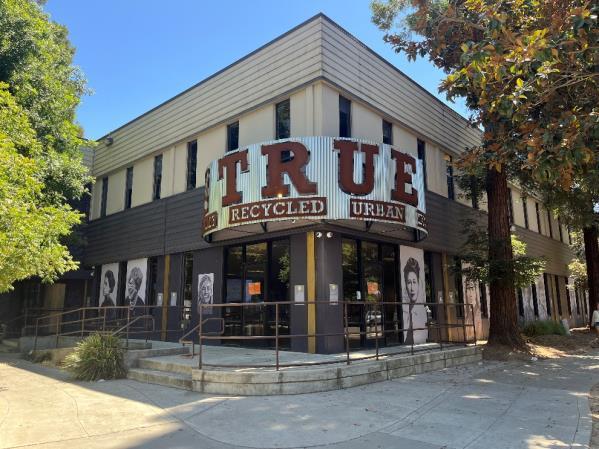
1900 K Street (APN 007-0084-023-0000)
Sacramento AIDS Foundation 1900 K Street was occupied by the Sacramento Aids Foundation from 19861994.
State of California The Resources Agency
DEPARTMENT OF PARKS AND RECREATION
CONTINUATION SHEET
Page 7 of 26
Primary #
HRI #
Trinomial
Resource Name or # (Assigned by recorder) Lavender Heights Historic District
*Recorded by Page & Turnbull, Inc.
*Date September 25, 2024 Continuation Update
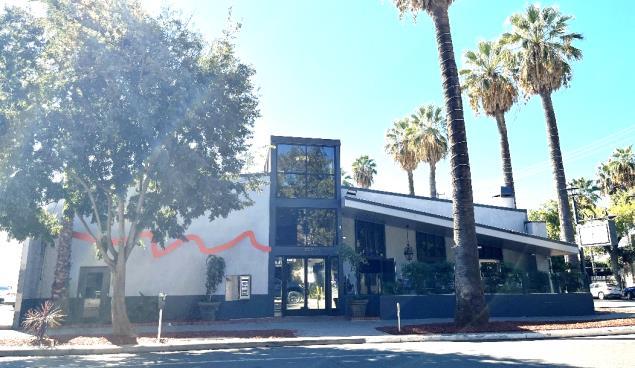
2000 K Street (APN 007-0086-020-0000)
K Street Station/Faces. 2000 K Street has been occupied by K Street Station/Faces since 1985.
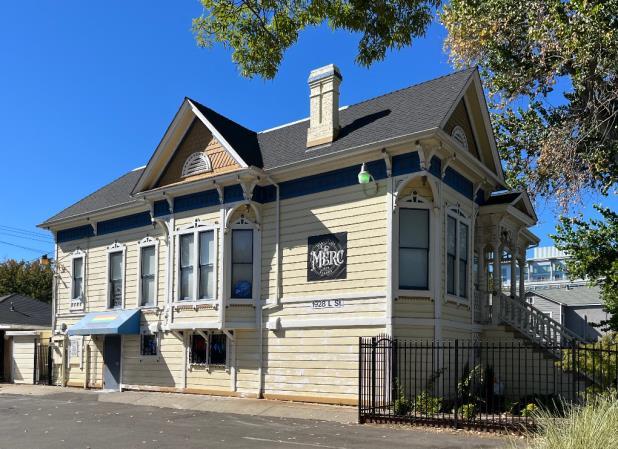
1928 L Street (APN 007-0143-007-0000)
Mercantile Saloon. 1928 L Street has been occupied by the Mercantile Saloon since 1976.
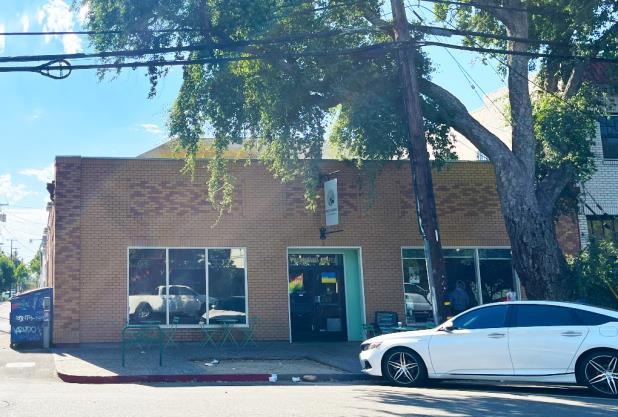
919 20th Street (APN 007-0016-017-0000)
Lambda Community Center. 919 20th Street was occupied by the Gay and Lesbian Community Center, Lambda Community Center, Lambda Players, and Stop
DPR 523L (Rev. 1/1995)(Word 9/2013)
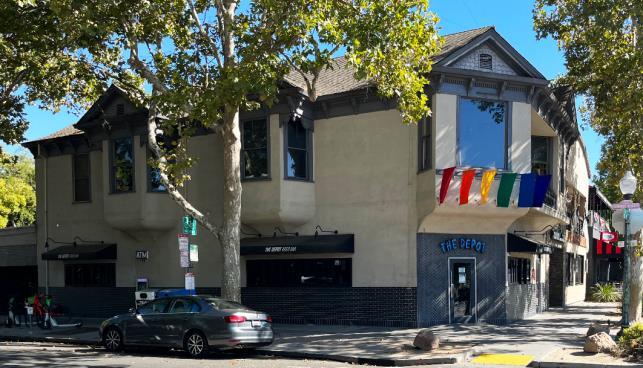
2001 K Street (APN 007-0085-012-0000)
2001 K Street has been occupied by a bar since 1938 and first became known as a gay bar at an unknown date. It has been a gay bar called The Depot since 1997
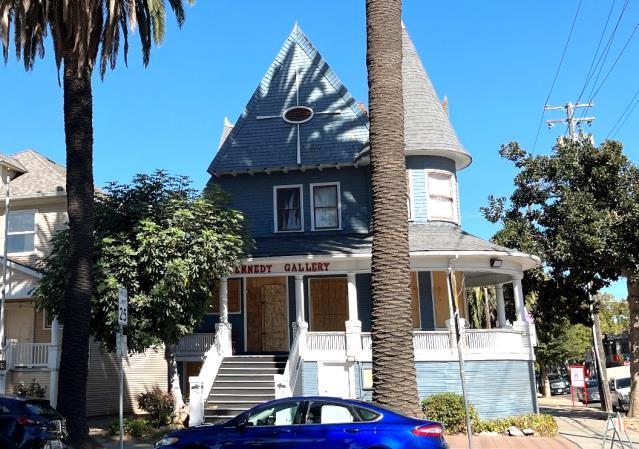
1931 L Street (APN 007-0084-030-0000)
Lambda Community Center 1931 L Street was occupied by the Gay and Lesbian Community Center, Lambda Community Center, Lambda Players, and AIDS Response Program from 1987-1998
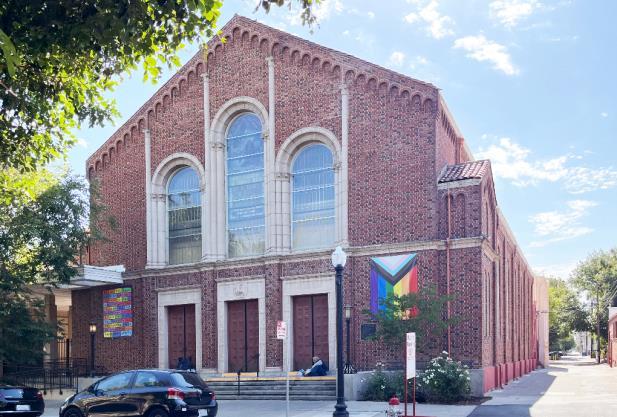
2100 J Street (APN 007-0091-001-0000)
First United Methodist Church The church hosted meetings for early homophile groups in the late 1960s and has continuously welcomed members of the
State of California The Resources Agency Primary #
DEPARTMENT OF PARKS AND RECREATION HRI #
CONTINUATION SHEET
Page 8 of 26
Trinomial
Resource Name or # (Assigned by recorder) Lavender Heights Historic District
*Recorded by Page & Turnbull, Inc.
AIDS Project from 1997-1999.
D6. Significance: (continued)
Lavender Heights Historic Context
Neighborhood Development
*Date September 25, 2024 Continuation Update
LGBTQ+ community
Sacramento’s LGBTQ+ community remained largely underground until the 1970s due to widespread discrimination and harassment The increasing visibility of LGBTQ+ individuals following the Stonewall Inn riots in New York City in 1969 and repeal of California’s anti-sodomy laws in 1975 led more people to come out the closet and begin to form visible communities across the country in the 1970s. In Sacramento, several factors contributed to the development of a visible LGBTQ+ community in Sacramento’s Midtown neighborhood during this period During the postwar period, the flight of wealthy residents and resources out of the older neighborhoods within and near Sacramento’s original street grid, known as the Central City, to newer suburbs in outlying areas resulted in a decline of property values and rents in the Central City.1 Young, single people, some of whom were gay, moved into the area, attracted by the abundance of lowrent apartment houses, excitement of urban life, and greater tolerance for alternative lifestyles than suburban areas The Midtown neighborhood, which had an eclectic mix of aging, affordable residences in close proximity to commercial streets, became a particularly popular destination for young gay and lesbian residents.2
Likely drawn to Midtown by the growing number of gay and lesbian residents in the area, gay-friendly businesses began to open in the 1970s. As with many gay neighborhoods throughout the United States, the first seeds of the Lavender Heights neighborhood were planted by the establishment of several gay bars traditionally the center of gay life –around the intersection of 20th and K streets As will be described in more detail later in this evaluation, some of the earliest and most prominent gay bars in the neighborhood were the Mercantile Saloon, The Western (later The Depot), Club 21, K Street Station (later Faces), and the Wreck Room, all of which were located at or within a few blocks of 20th and K streets. The name “Lavender Heights” was coined by members of Sacramento’s gay community in the 1970s, but it did not become more publicly used until the early 1980s, when the Sacramento Bee published a series of articles highlighting the neighborhood and several of its businesses. Although the origin of the neighborhood’s name is unknown, the color lavender was a reference to the popular association of the gay community with the color purple. Another name, “Fruit Flats,” was reportedly considered for the neighborhood and showed the community’s sense of humor but did not catch on.
As more LGBTQ+ individuals moved into Midtown, and the number of gay businesses, institutions, and services grew, Lavender Heights became a community of congregation, a self-created and self-defined place where the LGBTQ+ community chose to establish itself and felt a collective sense of safety, acceptance, and awareness 3 A true community emerged in Lavender Heights that provided services for all aspects of daily life, including health and welfare services for women and people with AIDS 4 By the 1990s, Lavender Heights contained not just a concentration of gay bars but also a wide variety of restaurants, health clinics, community centers and service organizations, spiritual institutions, clothing stores, laundromats, shops, bookstores, beauty salons and barber shops, doctors, therapists, lawyers, dentists, and realtors that catered specifically to LGBTQ+ clientele.5 With such a variety of businesses and services specifically by and for LGBTQ+ residents, Lavender Heights became a relatively selfcontained and self-sufficient neighborhood.6 As the primary location throughout much of the surrounding area in which one could find businesses and services specifically intended to meet the needs and desires of LGBTQ+ individuals, it also served as the center for the Sacramento region’s broader LGBTQ+ community.7
Gay Bars in Lavender Heights
Gay bars – which had covertly served a vital role as some of the only LGBTQ+ individuals could openly express their sexual identities since the first decades of the 20th century – blossomed into the public center of LGBTQ+ life in the decades after the late 1960s. Gay bars became not just places to meet sexual partners; they developed into the de
1 Michael Andrew Claussen, “Lavender Heights: The Emerging Gay Community in Downtown Sacramento, California,” (M.A. thesis, California State University, Chico, 1998,), 140.
2 Robin Witt, "Gays Gain Acceptance, Visibility in Sacramento," Sacramento Bee, 12 September 1982: A1-A17.
3 Claussen, “Lavender Heights,” 84, 164.
4 Conversation between Tina Reynolds, Clare Flynn, and Henry Feuss, May 22, 2024, Sacramento, CA.
5 Witt, "Gays Gain Acceptance, Visibility in Sacramento.”
6 Claussen, “Lavender Heights,” 120.
7 Claussen, “Lavender Heights,” 122.
DEPARTMENT
Page 9 of 26
SHEET
Resource Name or # (Assigned by recorder) Lavender Heights Historic District
*Recorded by Page & Turnbull, Inc.
*Date September 25, 2024 Continuation Update
facto center of gay life, where LGBTQ+ individuals received and exchanged news, formed lasting friendships and romantic relationships, and organized social, professional, and political groups, clubs, and events.
The development of the first openly gay-friendly social gathering places and business establishments in Sacramento did not occur overnight. Through the late 1960s and into the early 1970s, as much of the gay community remained closeted and being publicly “out” could still put one at risk of arrest, losing one’s job, and being ostracized from family, friends, and coworkers, gay and lesbian individuals continued to meet in secret. While some gay bars existed in Sacramento’s Central City grid prior to the late 1960s, California’s anti-sodomy laws, which had been used to harass and imprison LGBTQ+ individuals for over 100 years, and the City of Sacramento’s strict enforcement of those laws, prevented the formation of any recognizable concentration of gay-owned or gay-friendly establishments within the boundaries of the City of Sacramento until the state laws were repealed in the 1970s. As a result, nearly all gay bars and other business establishments that welcomed LGBTQ+ patrons existed across the Sacramento River in the unincorporated town of West Sacramento, which was located in a separate county, through the early 1970s. In 1975, Assembly Bill 437, which ended California’s sodomy laws, passed both houses of the California state legislature and was signed into law by Governor Jerry Brown, Jr.8 The impact of the repeal of the state’s sodomy laws was visible in the pattern of development of gay bars and gay-friendly establishments in the Sacramento area. Over the course of the 1970s and 1980s, the number of gay bars and queer-friendly establishments steadily increased and spread throughout the City of Sacramento as policing of sexual activities decreased.
One of the first gay bars in Lavender Heights was the Mercantile Saloon, which opened at a converted Victorian house at 1928 L Street (extant, contributing property to Lavender Heights Historic District) in 1976. Lovingly nicknamed “The Merc,” it was credited with making gay nightlife more visible in Sacramento. The Merc was owned by local restauranteur Bill Christie Christie was also the owner of a prime rib restaurant called Christie’s Elbo Room nearby at 2001 K Street (extant, contributing property to Lavender Heights Historic District), which later became a series of gay bars. The bar became known for welcoming gay Black men at a time when many other gay bars did not. Ernie Brown a gay Black man who was also an Emperor of the Imperial Court of Sacramento (also known as CGNIE), board member of the George Sand Community Benefit Fund, and former owner of Ernie’s Place bar at 725 Tower Court in West Sacramento managed the bar in the 1980s Robert “Bobbette” Hoyos was another popular manager of the bar for 15 years from 1981 until his death in 1996.9 The Merc was less hostile toward gay Black men than most of Sacramento’s other gay bars. Together with a jazz bar called the Rose Cocktail Lounge across the street at 2001 L Street (demolished), The Merc, under Ernie Brown’s management, became the main bar and social gathering place for gay Black men in Sacramento 10 On Friday nights, tables five rows deep would be filled with gay Black men until the AIDS epidemic killed many of the bar’s gay Black patrons in the 1980s 11
The Western at 2001 K Street (extant, contributor to the Lavender Heights Historic District) was continuously operated by members of the Dallosta family from 1938 through the 1990s and took the name The Western around 1953 12 By at least the 1990s, it had a reputation as bar for older gay men 13 In 1997, TJ Bruce and his mother Marjorie purchased the building and reopened it as a gay bar called The Western Pacific Depot.14
8 Donna J. Graves and Shayne E. Watson, “Citywide Historic Context Statement for LGBTQ History in San Francisco,” 227-228.
9 “Hoyos, ‘Bobbette’ Robert,” Sacramento Bee, 15 November 1996: B7.
10 John Bennett, conversation with Clare Flynn and Henry Feuss, August 26, 2024, Sacramento, CA; Clarmundo Sullivan, conversation with Carson Anderson, August 9, 2024, Sacramento, CA.
11 Asa Salley, conversation with Clare Flynn and Henry Feuss, September 5, 2024, Sacramento, CA.
12 Sacramento city directories, 1938-1982, Ancestry.com; “Genevieve Mary ‘Gen’ (Domich) Dallosta,” Sacramento Bee, 27 November 2018.
13 Taylor Facha, text conversation with Clare Flynn, August 30, 2024, Sacramento, CA.
14 Cameron Jahn, "Club Plan Ignites Dispute," Sacramento Bee, 20 June 2002: D1.
State of California
DEPARTMENT OF PARKS AND RECREATION HRI #
CONTINUATION SHEET
Page 10 of 26
Trinomial
Resource Name or # (Assigned by recorder) Lavender Heights Historic District
*Recorded by Page & Turnbull, Inc.
*Date September 25, 2024 Continuation Update
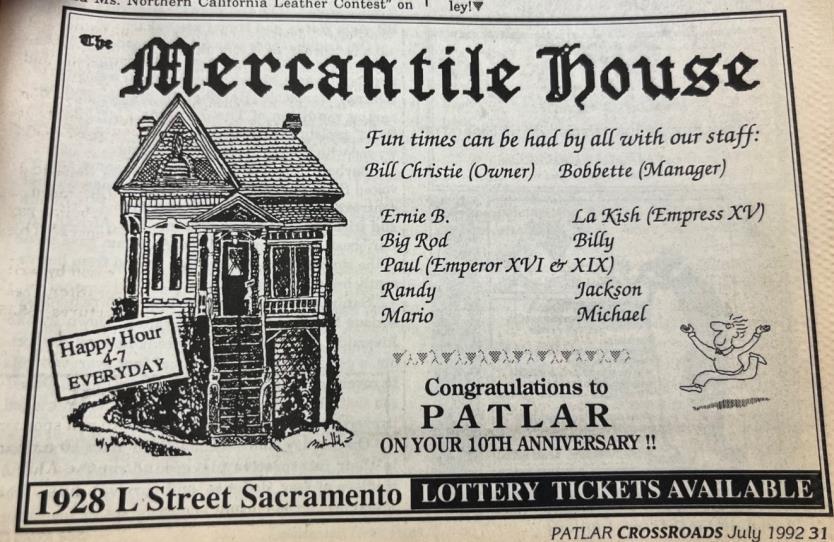
In 1981, Bernie Ferris opened Club 21 at 1122 21st Street (demolished and outside the historic district boundaries) with investors and brothers Clay and Bill Biscoe. Ferris received his teaching credential from Sacramento State University and initially worked as a grade school teacher for 17 years before coming out as gay in the late 1970s. After being publicly harassed at school by former students who had seen him at a local gay bar, he left the teaching career and went to work as a real estate agent for Century 21. In 1979, he met brothers Bill and Clay Biscoe, and the men decided to take over a straight bar called the Aero Tavern, which they named Club 21. The bar was immediately successful, attracting 350 people on an average Saturday night and receiving an award as the River City Business Association’s Business of the Year in 1982.15 Two years later, they closed Club 21 in order to open a larger bar in the building formerly occupied by Christie’s Elbo Room at 2001 K Street. The new bar was named K Street Station and had an upscale atmosphere with several bar areas and a full restaurant in a side room that was later converted into a video bar. The bar hosted art shows for local artists and had dancing every night. In spite of the bar’s popularity, its owners became overstretched and declared bankruptcy in 1985. Terry Sidie, who owned another popular gay bar called Bo Jangles near the Sacramento State University campus in East Sacramento, purchased the property and transformed it into a new bar called Faces in 1985. Ferris continued to work as the manager of Faces until 1994.16 The name Faces was coined by Incredible Edible Place restaurant owner Paul Fitzgerald and was intended to reflect that the bar was open to all communities and all “faces.” Sidie envisioned Faces as a destination for dancing and a luxurious alternative to the typical dive bar. By 2015, the bar featured three dance floors, each of which played different genres of music, 16 bar stations, and an outdoor swimming pool. A rainbow-colored triangular sign at the front door was installed that read “You are entering a gay bar! Respect us, and we’ll respect you!”17
15 Bill Lindelof, “Gay Bars Flourish in Downtown Area As Places to Relax, Find Partners,” Sacramento Bee, 12 September 1982: A16.
16 Bernie Ferris, “Bernie Ferris History,” undated, courtesy of Christine Ferris.
17 Chris Macias, "Celebrating Inclusion," Sacramento Bee, 5 September 2015: B1, B6.
523L (Rev. 1/1995)(Word 9/2013)
State of California The Resources Agency Primary #
DEPARTMENT OF PARKS AND RECREATION HRI #
CONTINUATION SHEET
Page 11 of 26
Trinomial
Resource Name or # (Assigned by recorder) Lavender Heights Historic District
*Recorded by Page & Turnbull, Inc.
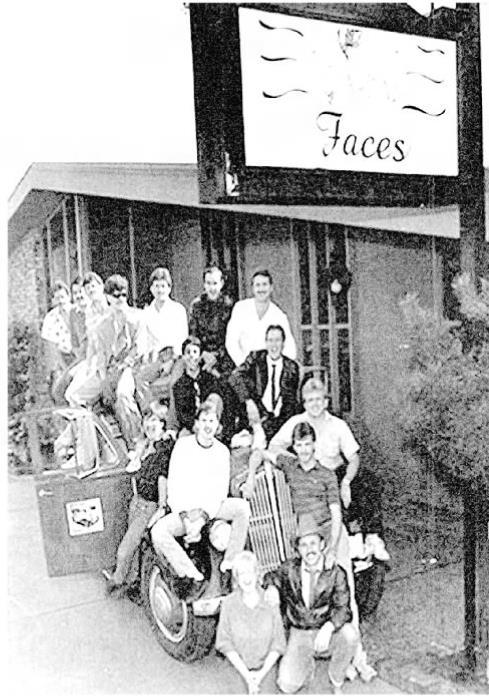
*Date September 25, 2024 Continuation Update
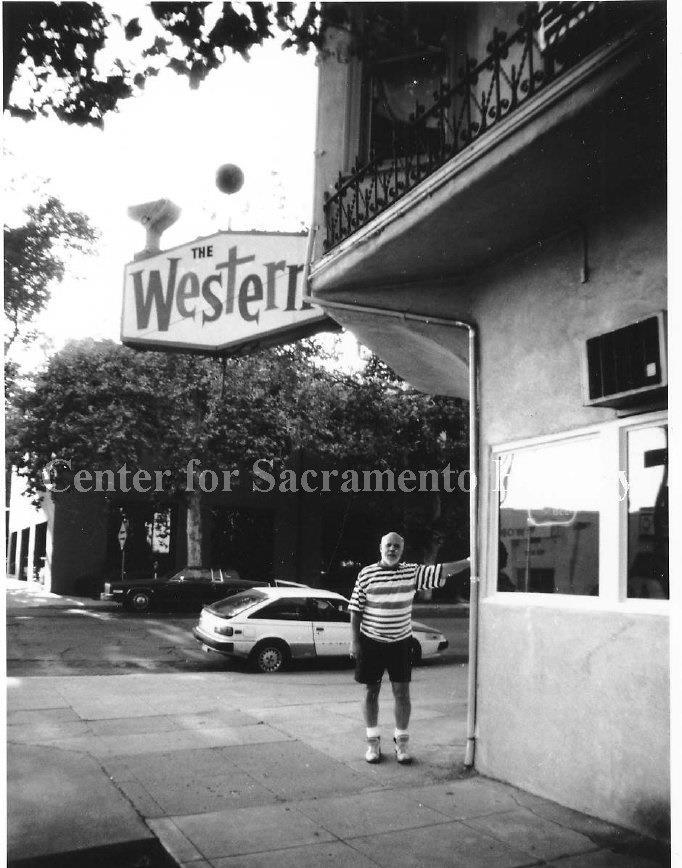
The success of Faces, in particular, brought a groundswell of energy to the intersection of 20th and K Streets, which would become the heart of Lavender Heights. Steve Hansen, the first openly gay City Councilman in Sacramento’s history, described Faces as “that initial piece of life that built this reef of activity [in Lavender Heights].” In 2015, Sidie reflected back that prior to the opening of K Street Station and its reopening as Faces, the neighborhood around 20th and K streets “was nothing. It was broken-down garages, an empty funeral parlor. There was a down bar called The Western. Lewis Florist was falling into the ground. It wasn't called 'Lavender Heights.' They didn’t even call it 'midtown.’"18 Under Sidie’s leadership, Faces became akin to a community center.
Born and raised on a farm in Wisconsin, Sidie left home at the age of 19 to live with an aunt in Detroit, where he came out as gay. He later moved to Los Angeles, where he worked as a private-duty nurse before enlisting in the military in 1971. Though hoping “to see the world,” he was stationed at the hospital at Mather Air Force Base in the Sacramento area. In the evenings, he moonlighted as a bartender at bars in Sacramento and West Sacramento, gaining experience with the local gay bar scene. After opening Bo Jangles in 1976, Sidie became one of the most successful and influential figures in Sacramento’s LGBTQ+ community, opening several other bars, restaurants, and establishments, and supporting community clubs and organizations through donations and fundraisers. At one point, Sidie owned Bojangles and Faces, as well as the reopened Club 21 (which operated through the early 2000s), a restaurant called Head Hunters, the Verona Village Resort in Sutter County, and a farm in his home state of Wisconsin. Sidie used the success of his business endeavors to benefit and empower Sacramento’s LGBTQ+ community. Faces became a hub for the community and arguably the most well-known and recognizable landmark for the LGBTQ-life in Sacramento. In addition to its regular business, the bar hosted events such as voter drives for the Sacramento chapter of the gay political advocacy group the Stonewall Democratic Club, fundraisers for LGBTQ+friendly politicians, and the first meeting of the Sacramento Gay and Lesbian Softball League.19 In 1987, Sidie assisted Hamburger Mary’s owner Richard Boriolo in starting the Rainbow Festival The festival, which is held annually as a fundraiser for local LGBTQ+ charities and organizations, has continuously used Faces as its main hub.20 In reflecting on Sidie’s impact on the community, Reverend Jerry Sloan, founder of Sacramento’s LGBT
18 Chris Macias, "Celebrating Inclusion.”
19 Macias, "Celebrating Inclusion.”
20 Jolanne Tierney, conversation with Clare Flynn and Henry Feuss, August 2, 2024, Sacramento, CA
523L (Rev. 1/1995)(Word 9/2013)
DEPARTMENT
CONTINUATION SHEET
Page 12 of 26
Trinomial
Resource Name or # (Assigned by recorder) Lavender Heights Historic District
*Recorded by Page & Turnbull, Inc.
*Date September 25, 2024 Continuation Update
Community Center, stated, “"A lot of people and groups, including myself, have certainly gone to him and said, 'Terry, we need,' and he never hesitates. And we're talking thousands of dollars, not 20 bucks."21 By 1997, Sidie, himself, estimated he had given $120,000 to local LGBTQ+ charities and organizations.22
The character of Sacramento’s gay bars varied widely, reflecting the diversity of Sacramento's gay community. The Merc looked like a typical straight bar except that there were usually no women present. Club 21 had a similar “casual and friendly” atmosphere to The Merc, but differed from other local gay bars in hosting a clientele that consisted of gay doctors, lawyers, and other professionals.23 The Wreck Room a few blocks away at 925 20th Street (inside the historic district but a non-contributor due to alterations), was a leather bar that featured male underwear hanging on chains above the bar.24 Despite the differing characters of the city’s gay bars, community members reflected that Sacramento’s gay bar scene “had a closeness and unity that larger cities, such as Los Angeles and San Francisco, could only wish to have.”25 By 1982, an article in the Sacramento Bee estimated that roughly 3,500 to 5,000 of the city’s estimated gay residents frequented the city’s gay bars. By 1987, the Damron Guides – a directory and guidebook that listed gay-friendly businesses and cruising locations in cities across the United States – no longer showed any gay bars located in West Sacramento, indicating that the center of gay life had completed its shift east to Downtown and Midtown Sacramento.26
Community Centers & Services
The growing self-awareness among Sacramento’s LGBTQ+ residents that they were part of a larger underserved community came with the recognition that they needed to come together to help their own. Individuals stepped up and pooled their resources and social networks to found community centers, charities, and other service organizations to meet the community’s needs
Lambda Community Center / Sacramento LGBT Community Center
The most prominent and long-standing of Sacramento’s LGBTQ+ community centers, the Lambda Community Center (later renamed the Sacramento LGBT Community Center) was established in the 1980s, using funds procured by Reverend Jerry Sloan, founder of the Sacramento Metropolitan Community Church (MCC), the first religious congregation that was dedicated primarily to serving Sacramento’s LGBTQ+ community. As a young man, Sloan attended Baptist Bible College in Springfield, Missouri, where his classmate was Reverend Jerry Fallwell. Fallwell later became the leader of the Religious Right, founder of the Moral Majority political action committee, and an outspoken opponent of homosexuality. Sloan, meanwhile, came out as a gay man and founded chapters of the MCC in Kansas City, Missouri; Des Moines, Iowa; and Sacramento. On March 11, 1984, Falwell expressed his view that homosexuality was the embodiment of evil, stating, “Thank God this vile and satanic system will one day be utterly annihilated, and there will be a celebration in heaven."27 When Falwell and Sloan were guests on a television program in Sacramento a few months later, Falwell denied his statements and promised to pay Sloan $5,000 if he could provide taped evidence. Sloan produced the tapes, but Falwell refused to pay him, claiming that he had been misquoted. Sloan hired local attorney and lesbian legal pioneer Rosemary Metrailer and filed a lawsuit against Falwell and won nearly $9,000 in the settlement.28 After paying his legal fees, Sloan along with Timothy Warford, Terry Sidie, Marghe Covino, CGNIE Emperor Randy Hartman, and other community members used the rest of the winnings from the lawsuit to open the Lambda Community Center in the heart of the Lavender Heights district at 1931 L Street (extant, contributing property to Lavender Heights Historic District) in 1986.29 Sloan named a closet at the center of the building after Falwell.
21 Macias, "Celebrating Inclusion.”
22 Macias, "Celebrating Inclusion.”
23 Christine Ferris, “1980’s History of Sacramento LGBTQ Community,” email to Henry Feuss, July 10, 2024.
24 Lindelof, "Gay Bars Flourish in Downtown Area As Places to Relax, Find Partners.”
25 "Story - Bar History I, 1955-1995," undated, George Raya collection.
26 Mike Walker, "Damron Guide Reveals Sacramento Past," 2005, George Raya collection.
27 William Burg, Midtown Sacramento: Creative Soul of the City (Charleston, SC: The History Press, 2014), 41-42.
28 Burg, Midtown Sacramento, 41-42.
29 “History,” Sacramento LGBT Community Center, accessed April 11, 2024, https://saccenter.org/history. CGNIE is a continuously operating drag queen and drag king club and charitable organization with a hierarchy of officers, including an Emperor, Empress, Duchess, Lord, and Princess Royal.
State of California The Resources Agency
DEPARTMENT OF PARKS AND RECREATION
CONTINUATION SHEET
Page 13 of 26
Primary #
HRI #
Trinomial
Resource Name or # (Assigned by recorder) Lavender Heights Historic District
*Recorded by Page & Turnbull, Inc.
*Date September 25, 2024 Continuation Update
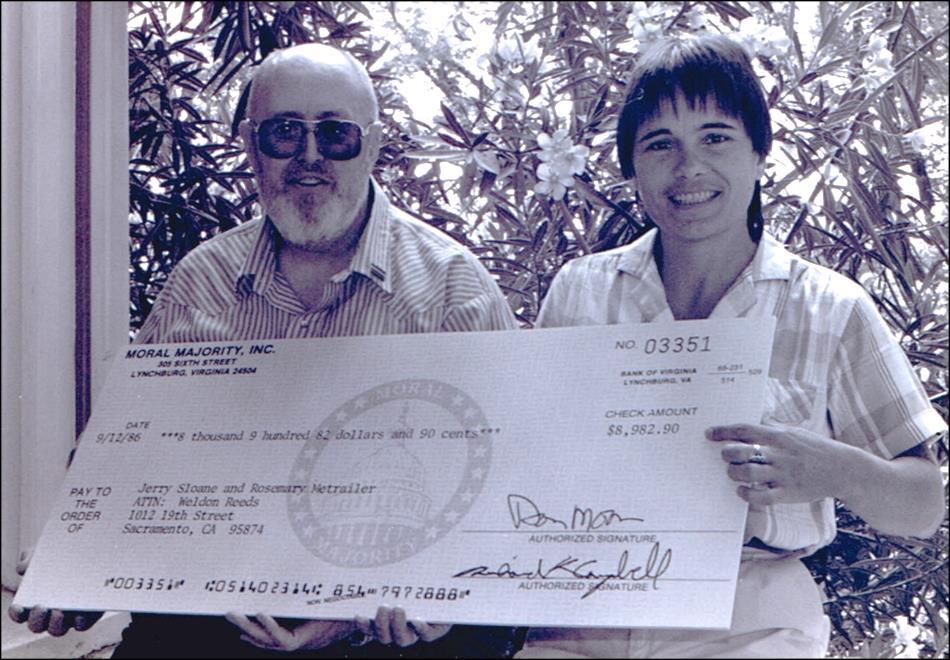
The Lambda Community Center was similar in some ways to earlier drop-in centers for gay residents, but it offered a larger and more comprehensive scope of services and over the years served the full cross-section of Sacramento’s gay, lesbian, bisexual, and transgender community.30 The center provided services such as AIDS education, a youth program, political lobbying and letter-writing campaigns, health education, and a monthly newsletter.31 A theatre troupe that performed plays with gay and lesbian themes, the Lambda Players, started at the Lambda Center on L Street in 1989 as an social and entertainment alternative to the gay bar scene. Between roughly 1997 and 1999, the center was located at 919 20th Street (extant, contributing property to Lavender Heights Historic District). The center changed its name to the Sacramento Gay and Lesbian Center in 2006 and again in 2013 to the Sacramento LGBT Community Center. The center moved to 1015 20th Street in 2019 (extant, non-contributing property outside the period of significance of the Lavender Heights Historic District) 32
30 Burg, Midtown Sacramento, 41-42.
31 Claussen, 142.
32 “History,” Sacramento LGBT Community Center, accessed April 11, 2024, https://saccenter.org/history
DPR 523L (Rev. 1/1995)(Word 9/2013)
State of California
DEPARTMENT
CONTINUATION SHEET
Page 14 of 26
Trinomial
Resource Name or # (Assigned by recorder) Lavender Heights Historic District
*Recorded by Page & Turnbull, Inc.
*Date September 25, 2024 Continuation Update
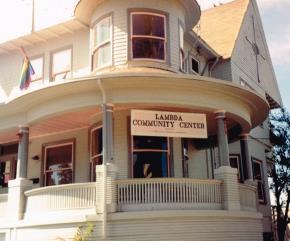
HIV/AIDS Community Services
The AIDS outbreak in the 1980s and the subsequent global pandemic was a watershed moment in history that led to profound loss, stigmatization, alienation for those within the LGBTQ+ community It had a profound impact on strengthening and unifying the community around a common cause. Members of the LGBTQ+ community quickly and harshly discovered how little support they had from within mainstream society and political institutions to help their sick and dying loved ones. Ostracized from mainstream society and lacking support or funding from government bodies and institutions, Sacramento’s gay and lesbian populations took on the responsibility of managing the spread of HIV and resulting AIDS cases and caring for the sick and dying largely by itself through the mid-1980s.33 At the forefront of local efforts were Dr. Harvey Thompson and Dr. Sandy Pomerantz, two Sacramento-based internal medicine physicians. Both members of the gay community themselves, Dr. Thompson and Dr. Pomerantz had mostly gay male patients and focused their work on the treatment of AIDS. Dr. Thompson opened a medical clinic, which mostly served gay men, at 910-912 21st Street (extant, contributing property to the Lavender Heights Historic District) in 1978. Dr. Pomerantz was a recent transplant from San Francisco and teamed up with Dr. Thompson to serve Sacramento’s gay community.34 Dr. Pomerantz authored a regular column that focused on health issues facing the gay community in the local gay newspaper Mom…Guess What…?!. His August 1981 column “Gay Medical Symposium: Two New Gay Illnesses” was the first mention in Sacramento of the disease that became known as AIDS.35 The Sacramento Bee did not step up its coverage until 1983.
In the fall of 1982, shortly after diagnosis of the first reported case of AIDS in Sacramento, Dr. Thompson and Dr. Pomerantz met with other members of the gay and lesbian communities to brainstorm methods to manage the further spread of AIDS within their community. The meeting held by Pomerantz and Thompson in 1982 was attended by Stanley “Stan” Hadden, a senior administrative aide to State Senate President Pro Tem David Roberti, and Dr. Elizabeth Harrison, a psychiatrist and contributor to Mom…Guess What…!. The meeting produced the early framework of what would become the AIDS/Kaposi’s Sarcoma Foundation, later changed to the Sacramento AIDS Foundation (SAF). Inspired by (and originally affiliated with) the San Francisco Aids Foundation, SAF officially began operation at 2115 J Street (extant, contributing property to Lavender Heights Historic District) in the spring of 1983
33 Amber Elena Piona, “How To Create Policy in an Epidemic: Aids in Sacramento, 1981-1989” (California State University, Sacramento, 2010), 28-29, Sacramento State University Library, 2–3.
34 Piona, "How To Create Policy in an Epidemic," 29.
35 Piona, "How To Create Policy in an Epidemic," 24.
523L (Rev. 1/1995)(Word 9/2013)
State
California
DEPARTMENT
CONTINUATION
Page 15 of 26
SHEET
Trinomial
Resource Name or # (Assigned by recorder) Lavender Heights Historic District
*Recorded by Page & Turnbull, Inc.
*Date September 25, 2024 Continuation Update
and provided educational advocacy along with emotional and hands-on support to patients through a service called “Hand to Hand.”36 Between 1984 and 1994, SAF was located 1900 K Street (extant, contributing property to Lavender Heights Historic District). SAF was a volunteer-run, community-funded organization. Much of the initial funding came from gay bars, including $4,000 from the leather community’s main hub, the Wreck Room, which was used to get the organization started. Funding for much of the first year of operations came from the Sacramento County Public Health Department and various fundraisers and donations.37 SAF worked in affiliation with the University of California, Davis (UC Davis) Medical Center, where Dr. Thompson served as an assistant clinical professor of medicine and family practice Other key leaders of SAF were Dr. Jerome Lackner and Dr. Neil Flynn, head of the UC Davis AIDS Clinic. Throughout this time, SAF played an integral and often intersectional role in Sacramento’s gay community, serving as a fundraiser for important medical and educational services and advocating for policy changes, among other capacities.
By 1983, studies had begun to indicate that AIDS was sexually transmitted, and Dr. Pomerantz was determined to relay this essential information to the gay community in the hope of slowing the spread of the disease.38 Dr. Pomerantz’s column in Mom…Guess What…!, along with others in the Sacramento Bee, highlighted the outreach that was done amongst Sacramento’s medical professionals to educate the gay community regarding sexual health and information on HIV, a vital service at a time when little information was known about HIV and AIDS.39 Dr. Thompson’s column in Mom…Guess What…! was eventually syndicated and distributed nationwide to the gay and lesbian press. Dr. Thompson died of AIDS in 1986 at the age of 45. Dr. Pomerantz died of AIDS in 1993 at the age of 44.40
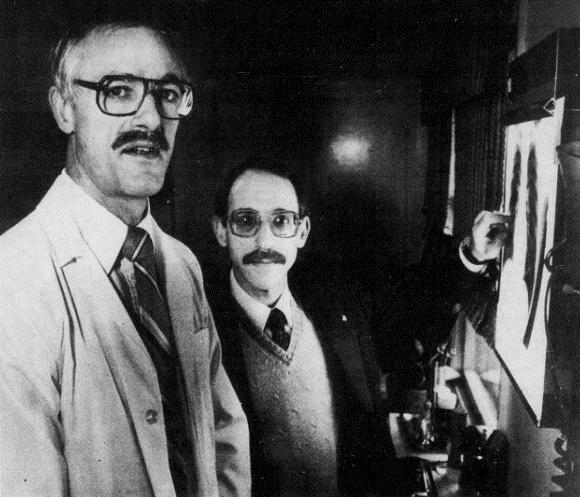
Women’s Services
In the 1970s, many women in Sacramento came together to create an expansive network of social services specifically for local women, including lesbians. Nationwide, many women, including Sacramento residents, were first introduced to community organizing and advocacy through the women’s liberation movement. The women’s movement attracted many lesbians, who faced the same issues as straight women and similarly sought recognition and equal rights. Seeking to uplift women and reject all forms of patriarchy that had historically been the source of their oppression, some of the more radical feminists came to believe that lesbianism, or love between women, and the rejection of all things male were the highest forms of feminism. These lesbian-feminists dreamed of creating self-
36 Piona, "How To Create Policy in an Epidemic," 29.
37 Piona, "How To Create Policy in an Epidemic," 29-30.
38 Don Stanley, “AIDS Nightmare: Puzzling, Deadly – And Spreading,” Sacramento Bee, 4 January 1983: A18-A19.
39 Piona, "How To Create Policy in an Epidemic," 3.
40 Robert D. Davila, “Noted AIDS Physician Dead at 44,” Sacramento Bee, 6 October 1993: B1.
523L (Rev. 1/1995)(Word 9/2013)
State of California
DEPARTMENT
CONTINUATION SHEET
Page 16 of 26
Trinomial
Resource Name or # (Assigned by recorder) Lavender Heights Historic District
*Recorded by Page & Turnbull, Inc.
*Date September 25, 2024 Continuation Update
sufficient, women-centered institutions and communities where women supported each other and were the primary drivers of culture and society.41
Inspired by the women’s movement, almost all of Sacramento’s first women’s services and aid organizations were started by lesbian-feminists, who took it upon themselves to support women in the community who were otherwise largely overlooked and underserved by institutional systems and authorities. Many of these women’s service organizations spawned from one organization, the Sacramento Women’s Center. The center began as the idea of a group of approximately 30 local feminist women, many of whom were students at local colleges – including Sacramento State, UC Davis, and American River College – as well as other local women’s groups, such as the YWCA and Sacramento Community Commission for Women. According to the Sacramento Bee, the group was led in its earliest phase by Judy Poxon, then a sophomore at Sacramento State, and Karen Burke Redman, a graduate student at UC Davis. From the start, the women envisioned the Sacramento Women’s Center as having the “feminist perspective” at the core of its mission. The center would be operated collectively to provide a broad base of support for the needs of Sacramento’s women. Modeled after women’s centers in Davis, Oakland, Berkeley, Santa Barbara, Seattle, and Vancouver, the vision for the Sacramento Women’s Center included providing temporary housing for women in need, a medical clinic, a children’s day care, job placement programs, classes, workshops, a library and bookstore, and referrals to relevant community aid agencies.42
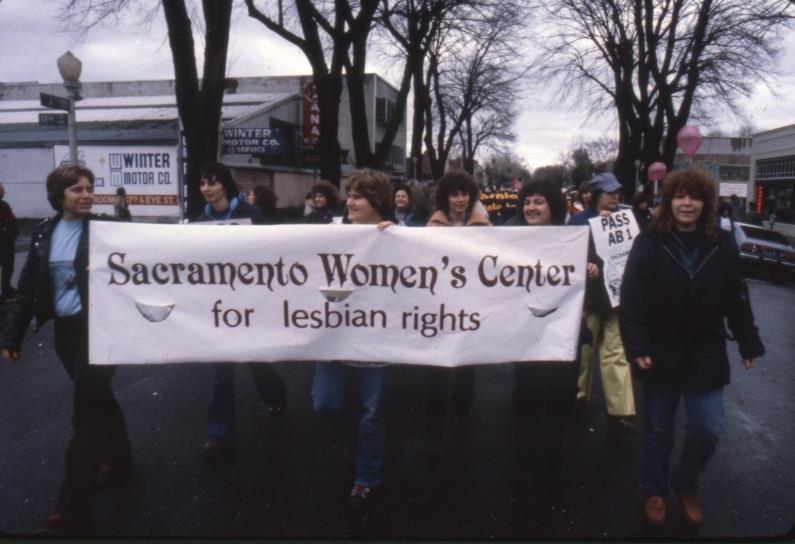
The Sacramento Women’s Center moved to several buildings across the Midtown and Downtown neighborhoods throughout the course of its existence. The earliest iteration of the center opened on Susan B. Anthony Day, February 15th, 1973, at the YWCA building at 1122 17th Street (extant but outside Lavender Heights Historic District). The center began by providing an identifiable and visible place for local women to come together to discuss women’s roles in society. The center relocated to its first standalone location, a house at 1221 20th Street (demolished and outside the Lavender Heights Historic District), in 1974. The Sacramento Bee published a feature on the center, which by this time had expanded into the Sacramento Women’s Center and Bookstore and had begun to offer some of the services its founders originally envisioned. One of those services was a rape crisis center (RCC). Although there was broad agreement among City officials and the police department about the need for such a program, the police department opposed it being run by the Sacramento Women’s Center, after they reported finding lesbian books, pamphlets, and posters at the center. With no evidence, they claimed that vulnerable women who had been
41 Lillian Faderman, Odd Girls and Twilight Lovers: A History of Lesbian Life in Twentieth-Century America (New York: Columbia University Press, 1991), 201-206.
42 Jan May Bassett, "Women's Center Will Have 'Feminist Perspective,' Sacramento Bee, 29 November 1972: 67.
DEPARTMENT
CONTINUATION
Page 17 of 26
SHEET
Trinomial
Resource Name or # (Assigned by recorder) Lavender Heights Historic District
*Recorded by Page & Turnbull, Inc.
*Date September 25, 2024 Continuation Update
physically and emotionally abused, would be coerced into becoming lesbians.43 Despite this opposition, the City awarded the Sacramento Women’s Center a $10,000 grant.44
In 1974, the center received a $178,000 grant from the federal Law Enforcement Assistance Administration (LEAA) to set up a program for women who were the victims of rape and other forms of sexual abuse.45 The grant was one of the largest federal grants for any project in the country at the time and made RCC one of the first rape crisis center to receive federal funding in the United States. However, it required $10,000 in matching funds from local sources. To match the federal funds, RCC borrowed the money from ten local woman, and RCC held self-defense classes, taught by Midge Marino, a black belt martial artist who taught self-defense at Sacramento State University’s Women’s Studies Program. RCC charged money for some of these classes to reimburse the women. Some of them in turn donated their money to RCC and others were paid back 46 RCC turned down a second year of funding from LEAA, after LEAA required that RCC disavow that any lesbians worked there and that the program establish a governing board, 50% of which consisted of law enforcement personnel, as conditions for continued funding. Both conditions were untenable to the Women’s Center.47
Initially led by Women’s Center members Inga Mountain and Kathy “Kit” Mahoney, by 1975, Kate Guzman, the newly formed Rape Crisis Center (RCC) provided 24-hours services for rape victims, including individual and group counseling, assistance dealing with the legal and hospital systems, self-defense classes and speaker series on women’s issues, and a 24-hour telephone hotline, which was staffed by volunteers who provided immediate emotional support to rape victims. The hotline received 145 calls in its first three months alone. It also gave educational sessions about sexual assault and abuse on local public television and at other women’s centers across California 48
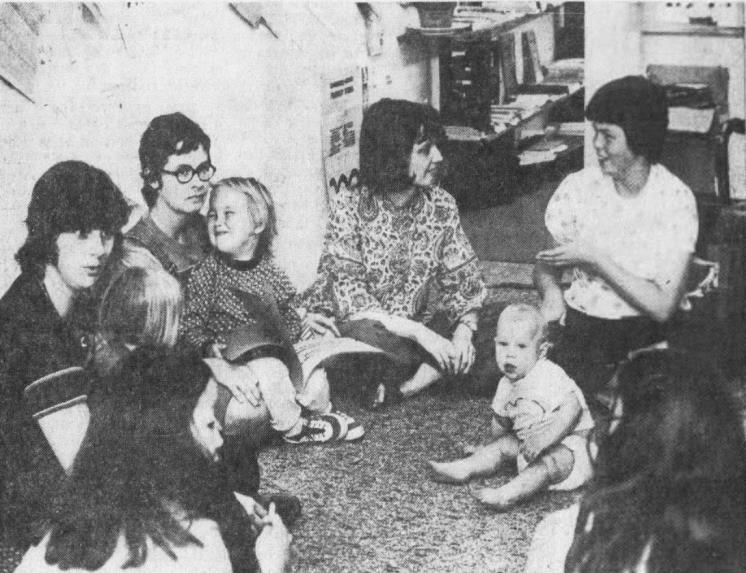
With calls for help pouring in, the staff of the Women’s Center discovered there were other serious unmet needs facing the women of Sacramento. Women who called in that were experiencing abuse needed a safe place for themselves, and sometimes their children, to stay to escape their abusers. The idea for a shelter evolved into a broad-reaching range of services for Sacramento’s low-income mothers. Claudia Deuel (also known as Claudia Desmangles) was a key figure in the development of such an agency within the Sacramento Women’s Center. Deuel was, herself, a single mother, who knew the struggles of low-income single mothers well. While completing her bachelor’s degree in psychology, she used welfare to care for her son and eventually became so physically
43 Jeff Raimundo, “Women ‘Appalled,’” Sacramento Bee, 12 July 1974: 21.
44 Bathen, “Women’s Center Raps Council Unit On Rape Crisis Funding.”
45 Sigrid Bathen, “Women’s Center Raps Council Unit On Rape Crisis Funding,” Sacramento Bee, 2 July 1975: B3.
46 Theresa Corrigan, conversation with Clare Flynn and Henry Feuss, July 25, 2024, Sacramento, CA.
47 Theresa Corrigan, “Edits,” email to Clare Flynn, September 25, 2024.
48 Sigrid Bathen, “Capital Rape Victim Helped Inspire New Legislation,” Sacramento Bee, 15 September 1974.
DEPARTMENT OF
CONTINUATION SHEET
Page 18 of 26
Trinomial
Resource Name or # (Assigned by recorder) Lavender Heights Historic District
*Recorded by Page & Turnbull, Inc.
*Date September 25, 2024 Continuation Update
debilitated that she had to be hospitalized with rheumatic fever and permanent heart damage.49 Initially, the Sacramento Women’s Center assisted single mothers by serving as a home for women to share childcare and household expenses, as well as an emotional outlet to discuss and process their feelings. In Spring 1974, the Sacramento Women’s Center submitted a grant proposal to Sacramento County to expand their services for lowincome mothers into a more comprehensive program, which would include a 24-hour hotline, a drop-in center, counseling services, a children’s playroom, a lending library, emergency clothing closet, and a referral service for legal aid, child care, pregnancy and birth control information, and housing assistance.50 The county awarded the center a $71,000 grant. The resulting organization was named Mothers Emergency Stress Service (MESS).51
In 1975, a group of abused Hispanic women formed a second separate organization to aid victims of domestic violence called Women Escaping A Violent Environment (WEAVE).52 In 1978, WEAVE was formally established as a nonprofit organization, and funding sources that had previously been allotted to MESS were shifted to WEAVE. MESS dissolved shortly after. By the mid-1980s, services offered by RCC were also absorbed into WEAVE 53
Despite this internal turmoil, the Sacramento Women’s Center persevered and continued to grow Under Guzman’s coordination, by the late 1970s, the organization had matured into a sophisticated and professional governmentfunded service center 54 In 1979, a new program, Women’s Employment Services Training (WEST), was established under the Women’s Center’s umbrella of services. The program was funded by a $200,000 federal grant for funds from the Comprehensive Employment and Training Act (CETA).55 Led by Robin Purdy, editor of the early feminist newsletter Gibbous Rising, WEST provided training for women who were struggling to find long-term employment and had been on welfare. The program offered trainings and workshops on topics such as resume writing and interview techniques, on-site career counseling, and travel vouchers and a clothing closet for women to attend job interviews.56
In 1980, Theresa Corrigan, who had been involved with the Women’s Center in many capacities – including as a staff member at RCC, author of the grant proposals that funded WEST and Women’s Stress Alternatives, and president of the center for a period – purchased the stock of the Women’s Center’s bookstore along with her partner Kathy Haberman and Karie Wyble with plans to continue the bookstore at a new location under a new name, Lioness Books. Seeking a property that the Sacramento Women’s Center and bookstore could call their own, without the risk of being forced to move, Corrigan and Haberman purchased a converted Colonial Revival house at 2224 J Street (extant, contributor to the Lavender Heights Historic District) in 1982. More than 35 volunteers, most of whom were women, volunteered their time mostly on weekends to renovate the old building for reuse. Haberman, who was a builder and handyperson, typically working 14-hour days, seven days a week, to bring the building up to commercial code.57 While the building at 2224 J Street was being renovated, Corrigan reopened the bookstore at a temporary location at 1311 21st Street (extant, non-contributor outside the Lavender Heights Historic District). Corrigan had renamed the bookstore Lioness Books, drawing inspiration from the role of female lions in a pride, because “in a pride of lions, the [male] lion gets all the credit, but the lionesses do all the work.”58 The Sacramento Women’s Store’s bookstore and Lioness Books were the first and only women’s and gay/lesbian bookstores in Sacramento for a number of years. Lioness Books fostered a welcoming and inclusive environment and worked together with other local bookstores to service the Sacramento community. Tower Books stopped carrying feminist and gay/lesbian literature and directed customers to Lioness Books, while staff at Lioness Books directed clientele who came looking for other types of literature to Tower and other local stores.59 Lioness Books was more than a bookstore; it was an important alternative for social gatherings, entertainment, and personal connection to the lesbian bar scene. For many lesbians who moved to Sacramento, it was the first place they came after they arrived and helped them make
49 Sigrid Bathen, "Women's Center Is for a Woman Alone Who Need Not Be," Sacramento Bee, 23 June 1974: 19.
50 Bathen, "Women's Center Is for a Woman Alone Who Need Not Be.”
51 Sigrid Bathen, "Control of Women's Center May Have Been Spark for Fatal Fray," Sacramento Bee, 3 April 1975: 17-19.
52 “WEAVE’s Journey,” WEAVE, accessed August 14, 2024, https://www.weaveinc.org/sites/main/files/file-attachments/40-yrtimeline-8.5x11_2.pdf?1518826703
53 Nurk Franklin, conversation with Clare Flynn and Henry Feuss, August 8, 2024, Sacramento, CA; Theresa Corrigan, conversation with Clare Flynn and Henry Feuss, July 25, 2024.
54 Cheryl Clark, "Women's Centers," Sacramento Bee, 12 April 1977: B4.
55 Nurk Franklin, conversation with Clare Flynn and Henry Feuss, August 8, 2024, Sacramento, CA.
56 Corrigan, conversation with Clare Flynn and Henry Feuss, July 25, 2024.
57 Corrigan, conversation with Clare Flynn and Henry Feuss, July 25, 2024; Alison apRoberts, “First Women’s Building True Labor of Love,” Sacramento Bee, 18 August 1983: 29.
58 Corrigan, conversation with Clare Flynn and Henry Feuss, July 25, 2024.
59 Corrigan, conversation with Clare Flynn and Henry Feuss, July 25, 2024.
State of California
DEPARTMENT
CONTINUATION
Page 19 of 26
SHEET
Trinomial
Resource Name or # (Assigned by recorder) Lavender Heights Historic District
*Recorded by Page & Turnbull, Inc.
*Date September 25, 2024 Continuation Update
some of their first connections. The bookstore hosted events and social gatherings, had bulletin boards with information about women’s and lesbian social groups and organizations, sponsored a softball team for Black lesbians called Sisters and Friends, and provided referrals to women’s, lesbian, and gay service providers.60
Around the same time the Women’s Center was relocating from Capitol Avenue to J Street, Kate Guzman left the Women’s center to become the executive director of the Sacramento AIDS Foundation. In 1983, Mayor Anne Rudin participated in the official opening ceremony of the building at 2224 J Street, which she designated the First Sacramento Women’s Building. Lioness Books occupied the first floor, and the offices of the Sacramento Women’s Center’s programs – including RCC and WEST – were located on the second floor. As previously described, RCC’s services were eventually absorbed into WEAVE. Lioness Books closed in 2000, making it the longest continuously operating location of the Sacramento Women’s Center and its associated agencies.61
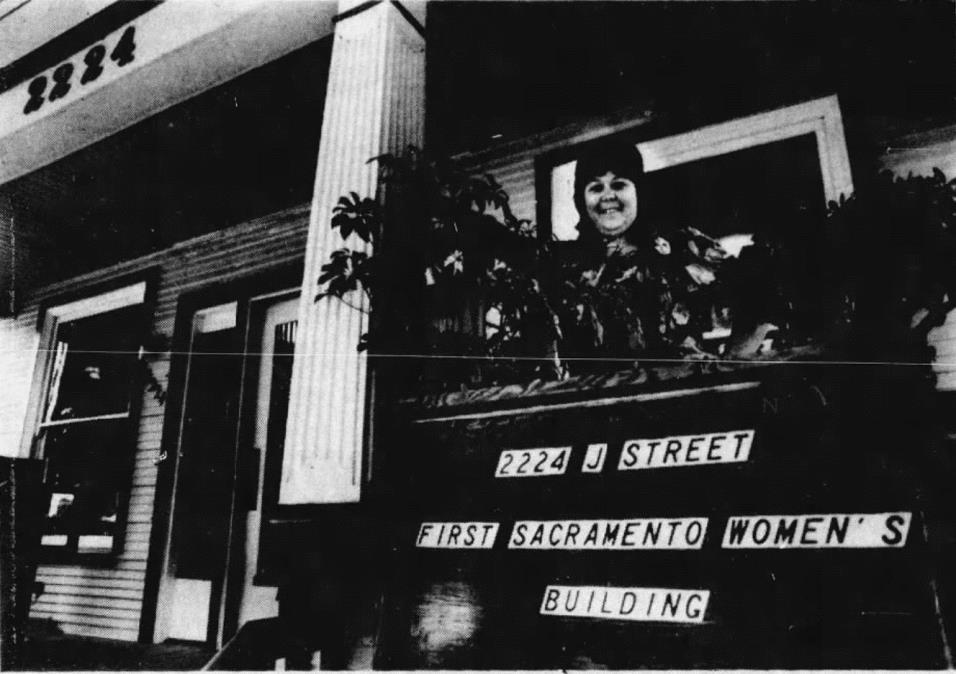
Other Social & Community Connectors
In addition to Lioness Books and events at the Lambda Community Center, Lavender Heights offered several opportunities for members of the LGBTQ+ community to meet and make connections outside the gay bar scene. The First Methodist Church at 2100 J Street (extant, contributing property to the Lavender Heights Historic District) hosted the earliest recorded LGBTQ+ event in Lavender Heights in 1967. That year, Sacramento’s earliest LGBTQ+ advocacy group, Americans For Responsible Citizenship (ARC), hosted a forum titled “The Homosexual 1967 Sacramento” at the church.62 The First Methodist Church has had a continuous reputation for welcoming and offering a spiritual outlet for the LGBTQ+ community since that time
In 1989, David Kwong, a former banker and founding member of the Sacramento Gay Men’s Chorus, opened a gardening supply and design store called the Gifted Gardener in 2220 J Street (extant, contributing property to the Lavender Heights Historic District), one of the locations previously used by the Sacramento Women’s Center. The store operated there for a little more than a year, before moving to a new location at 1730 H Street (extant, noncontributor outside the Lavender Heights Historic District), where it remained for nearly 30 years.63
60 Corrigan, conversation with Clare Flynn and Henry Feuss, July 25, 2024.
61 Haines Criss-Cross directories, Sacramento, 1982-1999; Theresa Corrigan, conversation with Clare Flynn, August 27, 2024.
62 William Burg, Sacramento Renaissance: Art, Music & Activism in California ’s Capital City (Charleston, SC: The History Press, 2013), 113.
63 Cathie Anderson, “Midtown Sacramento’s Gifted Gardener Will Close,” Sacramento Bee, 28 March 2017: A2.
523L (Rev. 1/1995)(Word 9/2013)
DEPARTMENT
CONTINUATION SHEET
Page 20 of 26
Trinomial
Resource Name or # (Assigned by recorder) Lavender Heights Historic District
*Recorded by Page & Turnbull, Inc.
*Date September 25, 2024 Continuation Update
In 1996, Larry Bailey and Ron Grantz opened a second gay and lesbian bookstore, The Open Book, in the neighborhood at the building formerly occupied by Dr. Harvey Thomson and Dr. Sandy Pomerantz’s offices at 910912 21st Street (extant, contributing property to the Lavender Heights Historic District). The Open Book stayed open until midnight and also contained a café that hosted small live music performances, offering an important alternative for late-night socializing.64
Classified ads published in issues of the Mom Guess What…! newspaper frequently provided a means for gay and lesbian individuals met each other and found romantic relationships. People would place an ad in the newspaper and typically list a P.O. box address as their contact in order to keep their personal addresses private. According to Sacramento resident and former State Assemblyman Dennis Mangers, it was common for gay individuals to meet for coffee at New Helvetia café located in the former fire station at 1215 19th Street (extant, contributing property to the Lavender Heights Historic District) or for some other activity after work.65
Lavender Heights Post-2000s
The tight-knit character of Lavender Heights as an enclave primarily by and for members of the LGBTQ+ community shifted by the early 2000s as social acceptance of LGBTQ+ people, identities, and expressions became more common and a growing number of straight people began to patronize the area’s gay bars and businesses. As the LGBTQ+ community became more mainstream and the number of LGBTQ+-friendly businesses grew, competition increased and the drive to support LGBTQ+ businesses as an act of resistance, survival, and pride from within the LGBTQ+ community declined. Terry Sidie reflected that Lavender Heights lost much of its previous “oomph” by 2005. “There’s not the same energy as before,” he said.66 That year, the Open Book, a gay and lesbian bookstore closed, citing competition from other stores and waning support from LGBTQ+ patrons. Looking back on the evolution of Lavender Heights since the 1970s, Fred Palmer, publisher of the LGBTQ+ publication Outword Magazine, reflected in 2005, “[Lavender Heights] used to be a true 'gay ghetto' business district, but it's lost a lot of its gay focus. What that tells you is that the local gay community has grown up, that Sacramento in general is a safer place to be publicly gay."
67 Several community members confirmed in oral history interviews conducted in 2024 for the Sacramento LGBTQ+ Historic Experience Project that the close community-oriented character of Lavender Heights dissolved around the year 2000.
D6. Significance: (continued)
California Register of Historical Resources Evaluation
The California Register of Historical Resources (California Register) is an inventory of significant architectural, archaeological, and historical resources in the State of California. The evaluative criteria used by the California Register for determining eligibility are closely based on those developed by the National Park Service for the National Register of Historic Places. In order for a property to be eligible for listing in the California Register, it must be found significant under one or more of the following criteria:
1. (Events): Associated with events that have made a significant contribution to the broad patterns of local or regional history or the cultural heritage of California or the United States.
2. (Persons): Associated with the lives of persons important to local, California or national history.
3. (Architecture): Embodies the distinctive characteristics of a type, period, region or method of construction or represents the work of a master or possesses high artistic values.
4. (Information Potential): Has yielded, or has the potential to yield, information important to the prehistory or history of the local area, California or the nation.
Criterion 1 (Events): The Lavender Heights Historic District is significant under Criterion 1 as a distinct geographic area that contains a concentration of properties with significant associations to the history of Sacramento’s LGBTQ+ community. Properties within the district represent the founding locations, headquarters, primary meeting places, or
64 Walt Yost, “Booksellers Provide Rare, Eclectic Works,” Sacramento Bee, 13 June 1996: 2A.
65 “Sacramento Oral History Episode 2: Linda Birner and Dennis Mangers,” May 30, 2023, Center for Sacramento History, YouTube, accessed April 18, 2024, https://www.youtube.com/watch?v=O8t3BwNfUXk
66 Jon Ortiz, "No Longer a Sure Sell," Sacramento Bee, 14 April 2005: A1.
67 Ortiz, "No Longer a Sure Sell.”
DEPARTMENT OF
CONTINUATION SHEET
Page 21 of 26
Trinomial
Resource Name or # (Assigned by recorder) Lavender Heights Historic District
*Recorded by Page & Turnbull, Inc.
*Date September 25, 2024 Continuation Update
places of activity for LGBTQ+ businesses, clubs, organizations, advocacy groups, community or service centers, or other social, cultural, or community groups that made a significant contribution to the LGBTQ+ community during its formative years. The district is also significant for its association with historic patterns of the LGBTQ+ community’s participation in commercial, social, artistic, cultural, spiritual, or recreational pursuits and other aspects of daily life. Lavender Heights is significant as the home of several longtime LGBTQ+ cultural landmarks and for its role in fostering safe and accepting spaces for LGBTQ+ business owners and patrons since the late 1960s Following the early establishment of several gay bars and pioneering social clinics in the 1970s and early 1980s including the Mercantile Saloon, Faces, the Lambda Community Center/LGBT Community Center, and Sacramento Women’s Center and Bookstore (later Lioness Books), the neighborhood flourished into a hub for the LGBTQ+ community and has continued to attract new residents and businesses. Lavender Heights has played an important role in providing avenues for kinship, safe social networks, and mutual aid services to the LGBTQ+ community. The district became a self-defined space in which LGBTQ+ individuals could express themselves freely, pursue business opportunities, and seek a range of intersectional services during the HIV/AIDS epidemic of the 1980s and 1990s, when harsh discrimination was prevalent in most realms of society. Lavender Heights continues to be an important landmark of LGBTQ+ cultural heritage in Sacramento For these reasons, the Lavender Heights Historic District appears eligible under Criterion 1
Criterion 2 (Persons): The Lavender Heights Historic District is significant under Criterion 2 for its association with several LGBTQ+ persons who played an important role in the formation of a vibrant, tight-knit LGBTQ+ community in the City of Sacramento from the late 1960s to the early 2000s The district is closely associated with the important historic contributions of LGBTQ+ persons and community leaders, including Mom Guess What…! newspaper founder Linda Birner; Lambda Community Center/LGBT Community Center founder Reverend Jerry Sloan; AIDS treatment, research, and education pioneers Dr. Harvey Thompson and Dr. Sandy Pomerantz; local business and community leader and philanthropist Terry Sidie; and women’s services leaders Theresa Corrigan and Kate Guzman, among many others, each of whom played an important role in establishing a sense of community visibility, identity, connectedness, safety, support and standards of care for the LGBTQ+ community within Lavender Heights and across the broader Sacramento region For these reasons, the Lavender Heights Historic District appears to be significant under Criterion 2.
Criterion 3 (Architecture): The Lavender Heights Historic District does not appear to be significant under Criterion 3 As a grouping of buildings with construction dates ranging from around 1895 to 1972, the district contributors include several architectural styles, none of which are distinct examples. District contributors vary in scale, massing, and style, and do not conform to any cohesive style or period of construction. The district contributors also do not represent the work of a recognized LGBTQ+ architect, builder, designer, or creative individual, nor do they possess high artistic or historic value. Therefore, the district is not eligible under Criterion 3
Criterion 4 (Information Potential): The Lavender Heights Historic District does not appear to be significant under Criterion 4. The “potential to yield information important to the prehistory or history of California” typically relates to archeological resources, rather than built resources. When Criterion 4 (Information Potential) does relate to built resources, it is relevant for cases when a building itself is the principal source of important construction-related information. The historic district as a grouping does not appear to include construction methods or materials which, with further research, would yield important historical information.
Integrity
In order to qualify for listing in any local, state, or national historic register, a property or landscape must possess significance under at least one evaluative criterion as described above and retain integrity. Integrity is defined by the California Office of Historic Preservation as “the authenticity of an historical resource’s physical identity evidenced by the survival of characteristics that existed during the resource’s period of significance,” or more simply defined by the National Park Service as “the ability of a property to convey its significance.”68
The Lavender Heights Historic District retains overall integrity of location, setting, feeling, and association. The historic district and its contributing buildings remain in their original locations, and no buildings have been moved or
68 California Office of Historic Preservation, Technical Assistance Series No. 7: How to Nominate a Resource to the California Register of Historical Resources (Sacramento: California Office of State Publishing, 4 September 2001), 11; U.S. Department of the Interior, National Park Service, National Register Bulletin: How to Apply the National Register Criteria for Evaluation (Washington, D.C.: National Park Service, 1995), 44.
DEPARTMENT
CONTINUATION SHEET
Page 22 of 26
Resource Name or # (Assigned by recorder) Lavender Heights Historic District
*Recorded by Page & Turnbull, Inc.
*Date September 25, 2024 Continuation Update
rotated. While the surrounding neighborhood in Midtown Sacramento has evolved and experienced some development and changes in demographics since 2000, Lavender Heights retains its characteristic eclectic mixture of moderately scaled residential, commercial, and institutional buildings, which were built from the late 19th century to the present day and house a variety of businesses and community services. The district continues to have a thriving nightlife scene and retains its feeling of inclusivity and safety for the LGBTQ+ community thanks to the presence of new and legacy LGBTQ+ owned and occupied businesses, institutions, and service organizations, several of which have remained in continuous operation in their original locations since the district’s period of significance. Although some contributors to the historic district have been physically altered since 2000, integrity of materials, design, and workmanship are less essential for a district that is significant under Criteria 1/i and 2/ii. The contributors would still be recognizable today to LGBTQ+ individuals who visited them during the district’s period of significance. Lavender Heights continues to be strongly identified by the general population as the cultural, social, and historic center of Sacramento’s LGBTQ+ community and, therefore, retains its historic association with the community. As such, the Lavender Heights Historic District retains overall historic integrity.
Sacramento Register of Historic and Cultural Resources
The Sacramento Register of Historic and Cultural Resources (Sacramento Register) is the City of Sacramento’s official inventory of historic and cultural resources. In order to be listed as a local landmark, historic district, or contributing resource to a historic district, a building, structure, site, or feature must meet the following criteria and requirements for listing on the Sacramento Register, as outlined in Chapter 17.604.210 of the City’s municipal code:
B. Listing on the Sacramento Register Historic districts. A geographic area nominated as a historic district shall be listed on the Sacramento register as a historic district if the city council finds, after holding the hearing required by this chapter, that all of the requirements set forth below are satisfied:
1. Requirements.
a. The area is a geographically definable area; or
b. The area possesses either:
i. A significant concentration or continuity of buildings unified by: (A) past events or (B) aesthetically by plan or physical development; or
ii. The area is associated with an event, person, or period significant or important to city history; or
c. The designation of the geographic area as a historic district is reasonable, appropriate and necessary to protect, promote and further the goals and purposes of this chapter and is not inconsistent with other goals and policies of the city.
2. Factors to be considered. In determining whether to list a geographic area on the Sacramento register as a historic district, the following factors shall be considered:
a. A historic district should have integrity of design, setting, materials, workmanship and association;
b. The collective historic value of the buildings and structures in a historic district taken together may be greater than the historic value of each individual building or structure.
C. Listing on the Sacramento register-Contributing resources. A nominated resource shall be listed on the Sacramento register as a contributing resource if the council finds, after holding the hearing required by this chapter, that all of the following requirements are satisfied:
1. The nominated resource is within a historic district;
2. The nominated resource either embodies the significant features and characteristics of the historic district or adds to the historical associations, historical architectural qualities or archaeological values identified for the historic district;
3. The nominated resource was present during the period of historical significance of the historic district and relates to the documented historical significance of the historic district;
4. nominated resource either possesses historic integrity or is capable of yielding important information about the period of historical significance of the historic district; and
5. The nominated resource has important historic or architectural worth, and its designation as a contributing resource is reasonable, appropriate and necessary to protect, promote and further the goals and purposes of this chapter.
Page 23 of 26
Resource Name or # (Assigned by recorder) Lavender Heights Historic District
*Recorded by Page & Turnbull, Inc.
*Date September 25, 2024 Continuation Update
(B) Listing on the Sacramento Register – Historic Districts
(1) Requirements
(a) As described in the previous discussion on California Register Criterion 1, the Lavender Heights Historic District meets requirement (a) for listing on the Sacramento Register, because it is a geographically definable area, consisting of a collection of extant properties with known historic associations to the city’s LGBTQ+ community that are concentrated around the enclave’s epicenter at the intersection of 20th and K streets
(b) (i) As described in the previous discussion on California Register Criterion 1, the Lavender Heights Historic District meets requirement (b)(i) as an area that possesses a significant concentration of buildings unified by their association with the development of an identifiable LGBTQ+ enclave within the City of Sacramento during the LGBTQ+ community’s its formative years from the late 1960s to approximately the year 2000.
(b) (ii) The Lavender Heights Historic District meets requirement (b)(ii) As described in the previous discussion for California Register Criterion 2, the historic district is strongly associated with the development of a visible LGBTQ+ community within the City of Sacramento, as well as several significant individuals who were instrumental in the establishment, development, and growth of the LGBTQ+ community, including but not limited to Linda Birner, Reverend Jerry Sloan, Dr. Harvey Thompson, Dr. Sandy Pomerantz, Terry Sidie, Theresa Corrigan, Kate Guzman, and others.
(c) The Lavender Heights Historic District meets requirement (c) as it aligns with the goals and purposes of historic preservation in Sacramento, as well as the city’s other goals and policies. Lavender Heights is a vibrant, beloved centerpiece of Sacramento. Per the Sacramento City Code, the preservation of districts such as Lavender Heights enhances the “city’s economic, cultural and aesthetic standing, its identity and its livability, marketability, and urban character.”
(2) Factors to be considered
(a) As discussed in the integrity evaluation, the Lavender Heights Historic District retains integrity of location, setting, feeling, and association. As such, it retains sufficient overall integrity to meet this factor for consideration as a historic district.
(b) The Lavender Heights Historic District meets factor (2)(b), because its contributing properties represent a significant and distinguishable entity whose collective historic value is greater when taken as a whole.
(C) Listing on the Sacramento Register – Contributing Resources
Address Historic Name Property meets
1215 19th Street New Helvetia Roaster
919 20th Street Lambda Community Center, Lambda Players, and AIDS Response Programs (ca. 1997-1999)
912 21st Street Dr. Harvey Thompson and Dr. Sandy Pomerantz offices / The Open Book
The New Helvetia Roaster, located within the Lavender Heights Historic District, was an integral part of the district's community fabric from 1991 to 2002. As a site representing LGBTQ+ community life during the 1990s, it contributed to the district’s social and cultural narrative. Although no longer in use, it remains a key reflection of the district’s social and architectural characteristics from its active years. Its role in representing the district's evolution justifies its status as a contributing resource.
The Lambda Community Center, Lambda Players, and AIDS Response Programs, active from approximately 1997 to 1999, were significant in addressing AIDS and supporting LGBTQ+ communities. Situated within the Lavender Heights Historic District, this site played a crucial role in the district’s history of health advocacy and LGBTQ+ support. Despite no longer being in use, it maintains historical importance and reflects the district’s past efforts in these areas. Its historical impact supports its designation as a contributing resource.
The offices of Dr. Harvey Thompson and Dr. Sandy Pomerantz, which later became The Open Book, were significant from 1978 to 1987 and again from 1996-2005. Located within the Lavender Heights Historic District, these offices were pivotal in the LGBTQ+ cultural and social landscape. They were present during crucial periods of the district's history, including early in the AIDS crisis, adding to its narrative.
State of California
DEPARTMENT OF
CONTINUATION SHEET Trinomial
Page 24 of 26
Resource Name or # (Assigned by recorder) Lavender Heights Historic District
*Recorded by Page & Turnbull, Inc.
*Date September 25, 2024 Continuation Update
(C) Listing on the Sacramento Register – Contributing Resources
Address Historic Name
2100 J Street First United Methodist Church
2115 J Street Sacramento AIDS Foundation offices
Property meets all contributing resource criteria specified in Sacramento City Code section 17.604.210.C.1-5
Although the site is no longer in use, it retains historical significance and contributes to the district’s understanding of LGBTQ+ culture.
The First United Methodist Church, an ongoing institution from around 1967 to the present, is a key site within the Lavender Heights Historic District. It has been a continuous venue for LGBTQ+ events and activities, reflecting its importance in the district’s religious and social history. Its ongoing operation underscores its historical integrity and significance, making it a vital contributing resource for the district.
The First United Methodist Church, an ongoing institution from around 1967 to the present, is a key site within the Lavender Heights Historic District. It has been a continuous venue for LGBTQ+ events and activities, reflecting its importance in the district’s religious and social history. Its ongoing operation underscores its historical integrity and significance, making it a vital contributing resource for the district.
2220 J Street Sacramento Women's Center/ The Gifted Gardener
2224 J Street Lioness Books, Sacramento Women's Center, Rape Crisis Center, WEST
1900 K Street Sacramento AIDS Foundation offices
The Sacramento Women’s Center, active from 1975 to 1976, was an important site within the Lavender Heights Historic District. It contributed to women’s and LGBTQ+ advocacy during its operational years, enhancing the district’s historical narrative of support for marginalized groups. Despite its closure, the site’s historical significance in early advocacy efforts supports its designation as a contributing resource. The Gifted Gardener, a popular gay-owned business that operated in Sacramento for nearly 30 years, first opened at 2220 J Street in 1989.
Lioness Books, the Sacramento Women’s Center, Rape Crisis Center, and WEST, operating from approximately 1982 to 1999, were integral to the Lavender Heights Historic District’s advocacy network. These organizations contributed significantly to LGBTQ+ and women’s services, reflecting the district’s role in social activism. The site’s historical importance and its multifaceted role in community services justify its contributing status, despite its current non-use.
The Sacramento AIDS Foundation offices at 1900 K Street, active from 1986 to 1994, were an important part of the Lavender Heights Historic District’s efforts to address the AIDS crisis. While the offices are no longer operational, their historical role in health support and advocacy during a critical period of the district’s history underscores their significance. This historical impact supports its designation as a contributing resource.
2000 K Street K Street Station/Faces gay bar
2001 K Street The Western/The Depot gay bar
K Street Station, known as Faces gay bar since 1985, remains an active and significant venue within the Lavender Heights Historic District. It has played a crucial role in LGBTQ+ nightlife and culture, contributing to the district’s social and cultural history. Its ongoing operation and importance in the district’s LGBTQ+ community validate its status as a contributing resource.
The Western, later known as The Depot gay bar, has been a prominent LGBTQ+ venue since around 1997. Located within the Lavender Heights Historic District, it has significantly contributed to the district’s nightlife and cultural scene. Its continued operation and role in the district’s LGBTQ+ history affirm its historical integrity and importance as a contributing resource.
1928 L Street Mercantile Saloon gay bar
The Mercantile Saloon, a gay bar active since 1976, is a significant site within the Lavender Heights Historic District. It has been a key venue for LGBTQ+ social activities, reflecting the district’s historical narrative. Its ongoing operation and long-term contribution to the district’s community life support its designation as a contributing resource.
State of California
DEPARTMENT OF PARKS AND RECREATION
CONTINUATION
Page 25 of 26
SHEET
Trinomial
Resource Name or # (Assigned by recorder) Lavender Heights Historic District
*Recorded by Page & Turnbull, Inc.
*Date September 25, 2024 Continuation Update
(C) Listing on the Sacramento Register – Contributing Resources
Address Historic Name Property meets all contributing resource criteria specified in Sacramento City Code section 17.604.210.C.1-5
1931 L Street Lambda Community Center, Lambda Players, Stop AIDS Project
Conclusion
The Lambda Community Center and Stop AIDS Project, active from 1987 to approximately 1998, were pivotal in providing services and support to the LGBTQ+ community and addressing the AIDS epidemic within the Lavender Heights Historic District. This site significantly contributed to the district’s advocacy and support network during a critical period, underscoring its importance in the district's history. Although the site is no longer operational, its historical impact on public health and LGBTQ+ support justifies its status as a contributing resource.
The Lavender Heights Historic District appears to be eligible for listing on the California Register and Sacramento Register under Criterion 1/i for its association with important developments in establishing, supporting, and increasing the visibility of Sacramento’s LGBTQ+ community and as the home to many important LGBTQ+ businesses and organizations during the community’s formative years from the late 1960s to around the year 2000.The Lavender Heights Historic District also appears to be eligible for listing under Criterion 2/ii for its association with several important LGBTQ+ community leaders and businesspersons who made important contributions to the development and visibility of the community as a whole.
*D7. References
Anderson, Cathie. “Midtown Sacramento’s Gifted Gardener Will Close ” Sacramento Bee 28 March 2017: A2.
apRoberts, Alison. “First Women’s Building True Labor of Love ” Sacramento Bee 18 August 1983: 29.
Bassett, Jan May. "Women's Center Will Have 'Feminist Perspective.'” Sacramento Bee. 29 November 1972: 67.
Bathen, Sigrid. “Capital Rape Victim Helped Inspire New Legislation.” Sacramento Bee. 15 September 1974.
Bathen, Sigrid. "Control of Women's Center May Have Been Spark for Fatal Fray." Sacramento Bee. 3 April 1975: 1719.
Bathen, Sigrid. "Women's Center Is for a Woman Alone Who Need Not Be " Sacramento Bee 23 June 1974: 19.
Bathen, Sigrid. “Women’s Center Raps Council Unit On Rape Crisis Funding ” Sacramento Bee 2 July 1975: B3.
Burg, William. Midtown Sacramento: Creative Soul of the City Charleston, SC: The History Press, 2014
Burg, William. Sacramento Renaissance: Art, Music & Activism in California ’s Capital City Charleston, SC: The History Press, 2013.
Clark, Cheryl. "Women's Centers." Sacramento Bee. 12 April 1977: B4.
Claussen, Michael Andrew. “Lavender Heights: The Emerging Gay Community in Downtown Sacramento, California.” (M.A. thesis, California State University, Chico, 1998,).
Corrigan, Theresa. Conversation with Clare Flynn and Henry Feuss. July 25, 2024. Sacramento, CA.
Davila, Robert D. “Noted AIDS Physician Dead at 4.” Sacramento Bee. 6 October 1993: B1.
Facha, Taylor. Text conversation with Clare Flynn August 30, 2024 Sacramento, CA.
Faderman, Lillian. Odd Girls and Twilight Lovers: A History of Lesbian Life in Twentieth-Century America New York: Columbia University Press, 1991
State of California The Resources Agency
DEPARTMENT OF PARKS AND RECREATION
CONTINUATION
Page 26 of 26
SHEET
Primary #
HRI #
Trinomial
Resource Name or # (Assigned by recorder) Lavender Heights Historic District
*Recorded by Page & Turnbull, Inc.
*Date September 25, 2024 Continuation Update
Ferris, Bernie. “Bernie Ferris History ” Undated. Courtesy of Christine Ferris.
Ferris, Christine. “1980’s History of Sacramento LGBTQ Community.” Email to Henry Feuss. July 10, 2024.
Franklin, Nurk. Conversation with Clare Flynn and Henry Feuss. August 8, 2024, Sacramento, CA.
“Genevieve Mary ‘Gen’ (Domich) Dallosta,” Sacramento Bee, 27 November 2018.
Graves, Donna J., and Shayne E. Watson. “Citywide Historic Context Statement for LGBTQ History in San Francisco.” 2016.
Haines Criss-Cross directories, Sacramento, 1982-1999.
“History ” Sacramento LGBT Community Center. Accessed April 11, 2024, https://saccenter.org/history
Jahn, Cameron. "Club Plan Ignites Dispute " Sacramento Bee 20 June 2002: D1.
Lindelof, Bill. "Gay Bars Flourish in Downtown Area As Places to Relax, Find Partners." Sacramento Bee. 12 September 1983.
Macias, Chris. "Celebrating Inclusion." Sacramento Bee. 5 September 2015: B1, B6.
Ortiz, Jon. "No Longer a Sure Sell " Sacramento Bee 14 April 2005: A1.
Piona, Amber Elena. “How To Create Policy in an Epidemic: Aids in Sacramento, 1981-1989 ” California State University, Sacramento, 2010
Raimundo, Jeff. “Women ‘Appalled ’” Sacramento Bee 12 July 1974: 21.
Reynold, Tina. Conversation with Clare Flynn and Henry Feuss. May 22, 2024. Sacramento, CA.
“Sacramento Oral History Episode 2: Linda Birner and Dennis Mangers.” May 30, 2023. Center for Sacramento History, YouTube. Accessed April 18, 2024, https://www.youtube.com/watch?v=O8t3BwNfUXk
Stanley, Don. “AIDS Nightmare: Puzzling, Deadly – And Spreading.” Sacramento Bee. 4 January 1983: A18-A19.
"Story - Bar History I, 1955-1995 " Undated George Raya collection.
Tierney, Jolanne. Conversation with Clare Flynn and Henry Feuss. August 2, 2024. Sacramento, CA.
Walker, Mike. "Damron Guide Reveals Sacramento Past " 2005 George Raya collection.
“WEAVE’s Journey ” WEAVE. Accessed August 14, 2024, https://www.weaveinc.org/sites/main/files/fileattachments/40-yr-timeline-8.5x11_2.pdf?1518826703
Witt, Robin. "Gays Gain Acceptance, Visibility in Sacramento." Sacramento Bee. 12 September 1982: A1-A17.
Yost, Walt. “Booksellers Provide Rare, Eclectic Works.” Sacramento Bee. 13 June 1996: 2A.
DPR 523L (Rev. 1/1995)(Word 9/2013)
